Take Me to the Recipes!
Imagine a land where towering volcanoes cast dramatic shadows over lush rainforests, and vibrant markets overflow with exotic fruits and fragrant spices. This is Guatemala, a nation where history, geography, and climate weave a captivating tapestry – and nowhere is this more evident than on its plate.
Guatemalan cuisine is a symphony of flavors, a vibrant fusion born from the rich heritage of the Maya and the subsequent influence of Spanish conquistadors. But the story goes deeper. The unique volcanic soil, the temperate climate with its distinct regional variations, and the abundance of rainfall – all play a crucial role in shaping the ingredients, cooking techniques, and ultimately, the soul of Guatemalan food.
Join us on a delicious adventure as we delve into the heart of Guatemalan cuisine. We’ll explore how ancient traditions intertwine with modern influences, how geography dictates the ingredients that grace the table, and how the perfect blend of climate and volcanic bounty cultivates a truly unique culinary experience.
Prepare to tantalize your taste buds and embark on a journey where every bite tells a story – the story of Guatemala.
Take Me to the Recipes!
Guatemalan Cuisine – Key Takeaways
- Guatemala cuisine is a unique blend of indigenous Mayan, Spanish, and African influences
- The cuisine is characterized by a diverse range of spices, ingredients, and cooking techniques
- Traditional dishes such as stews and tamales are popular across the country
- Guatemalan cuisine is a feast for the senses, with mouthwatering flavors and textures
- Join us on a culinary journey to discover the rich and delicious world of Guatemalan cuisine
Where is Guatemala?

Guatemala shares borders with four countries (Mexico, El Salvador, Honduras and Belize) and has two coastlines, one on the Caribbean Sea and one on the Pacific Ocean.

Index to Article
- Take Me to the Recipes!
- More Articles
- 10 Fascinating Facts about Guatemala
- Guatemalan History and the Effect It Has Had on the Cuisine
- How Guatemala’s Climate and Geography Have Influenced Guatemalan Cuisine
- Understanding the Essence of Guatemalan Cuisine
- Guatemalan Culinary Traditions
- Exploring Guatemala’s Ingredients: The Flavors of Guatemalan Cuisine
- Mastering Guatemalan Cuisine Cooking Techniques
- Traditional Examples of Guatemalan Food
- Exploring Guatemalan Street Food
- The Most Popular Guatemalan Recipes
- What are the Health Implications of Guatemalan Cuisine?
- Guatemala’s National Dish
- A Kaleidoscope of Flavors: Guatemalan Food Specialties to try at Home
- Conclusion
- FAQ’s
You may also be interested in the following Articles
- North and South American Cuisine – A Culinary Expedition
- Europe Cuisine: Savor the Continent’s Best Culinary Secrets!
- African Cuisine: Discover the Bold Flavors & Global Charm!
- Asian Cuisine Unlock its Secrets – Taste, Health & Global Influence!
Savor iconic Guatemalan Food Recipes – Click on each tantalizing picture to open up the Recipe.
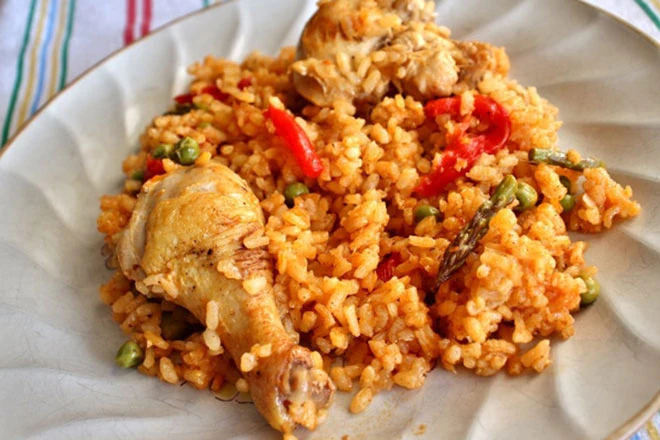
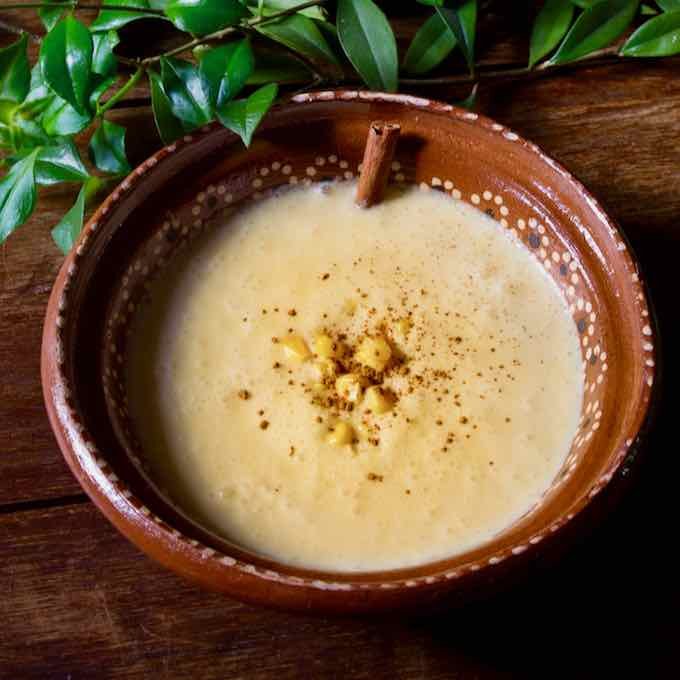
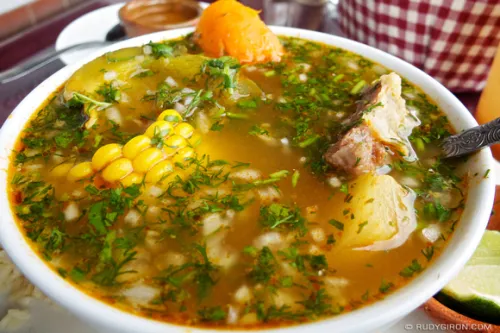

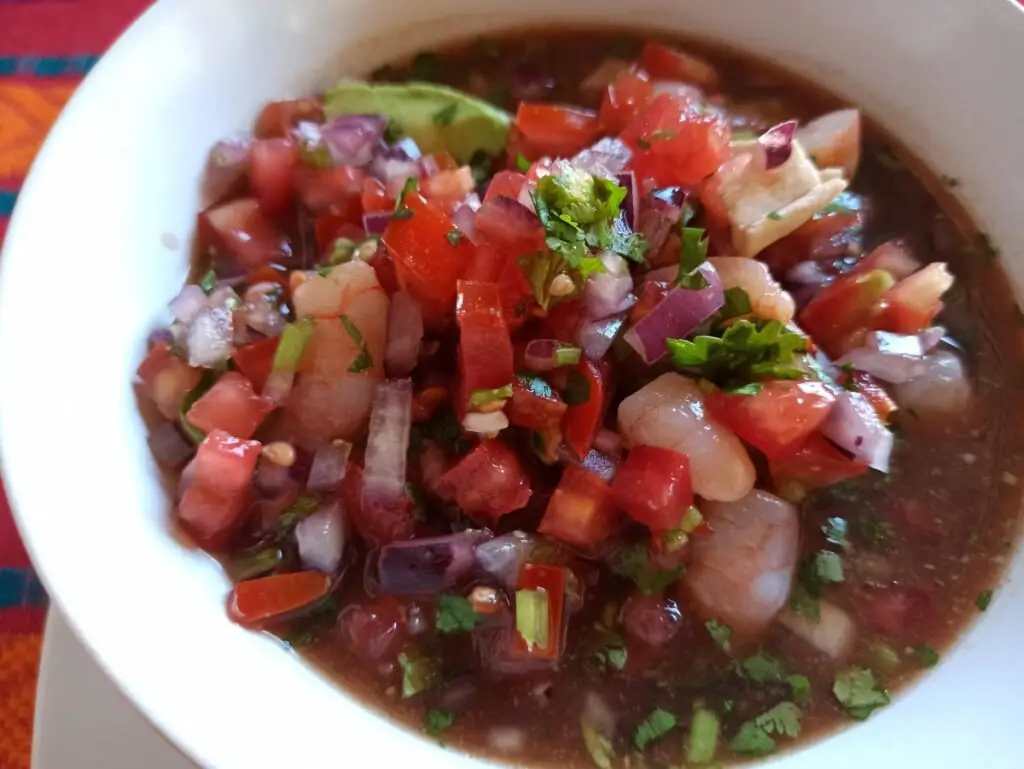




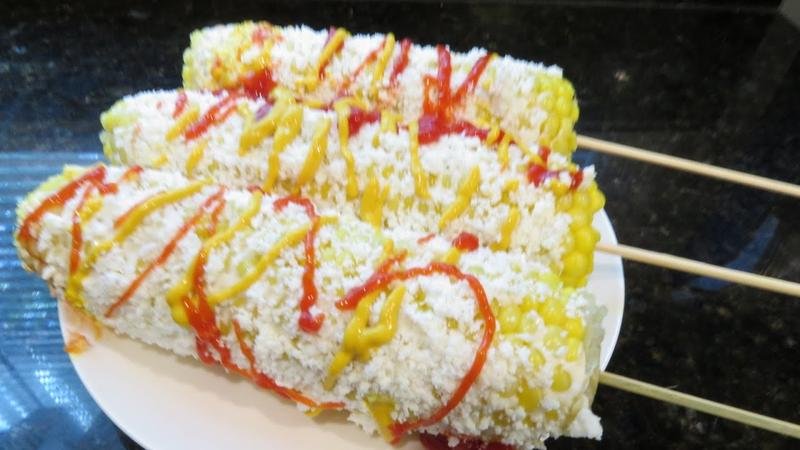


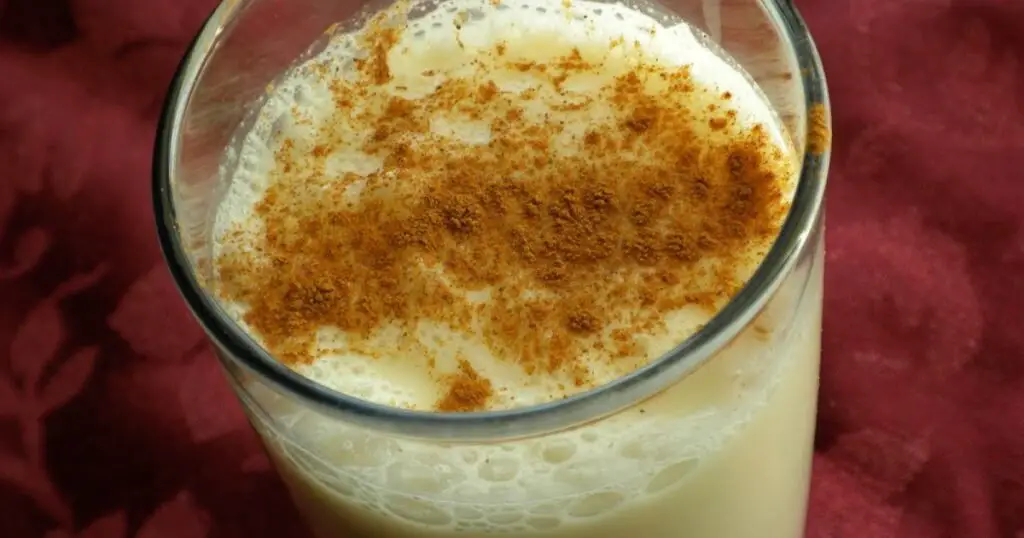
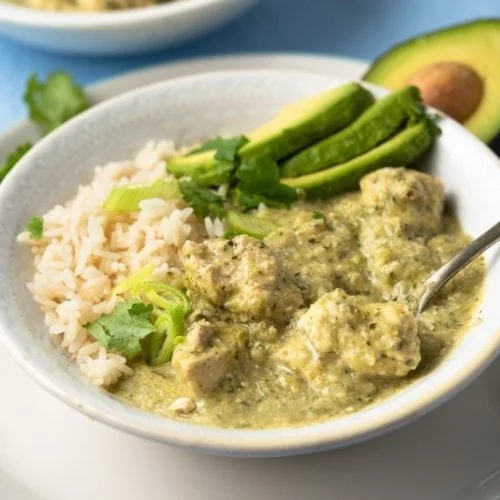


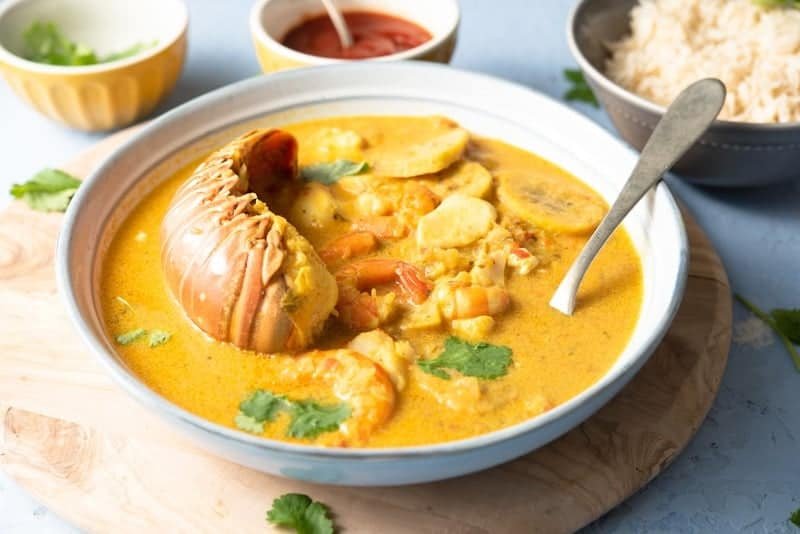
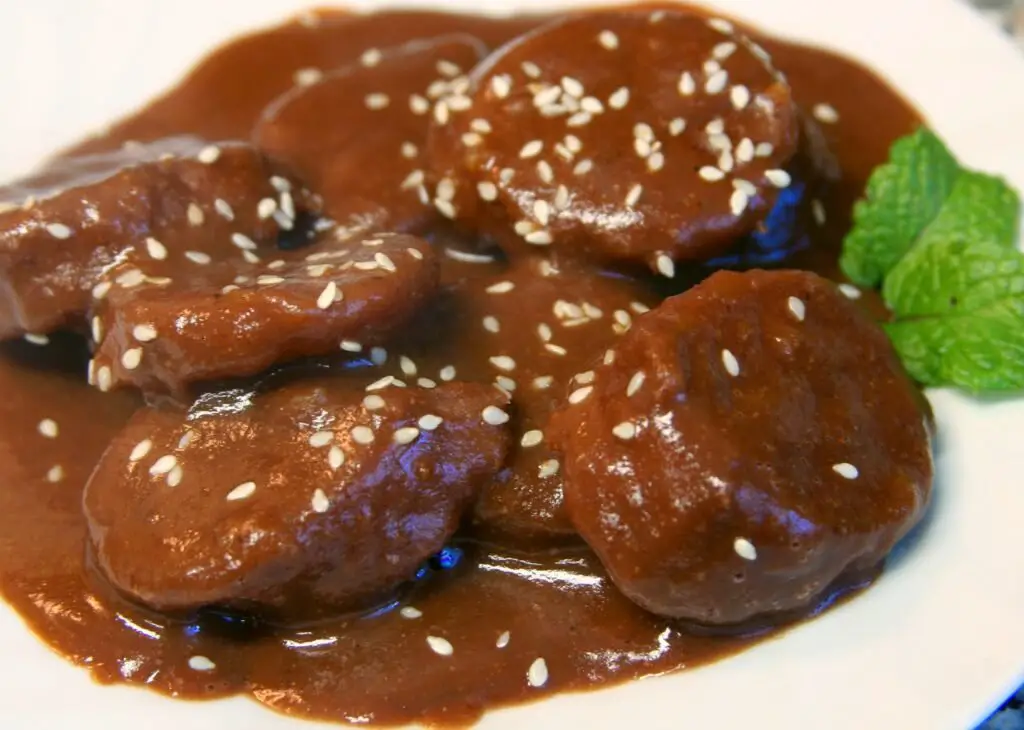
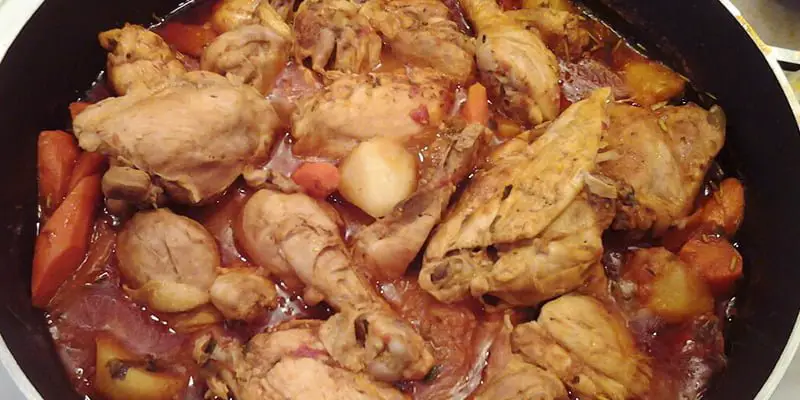
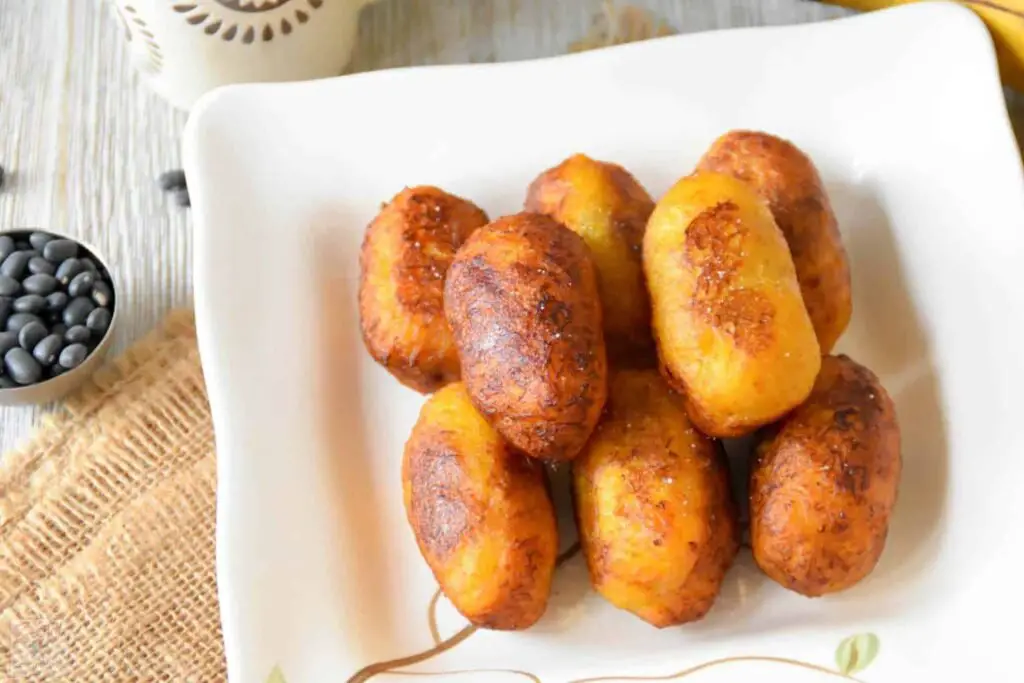

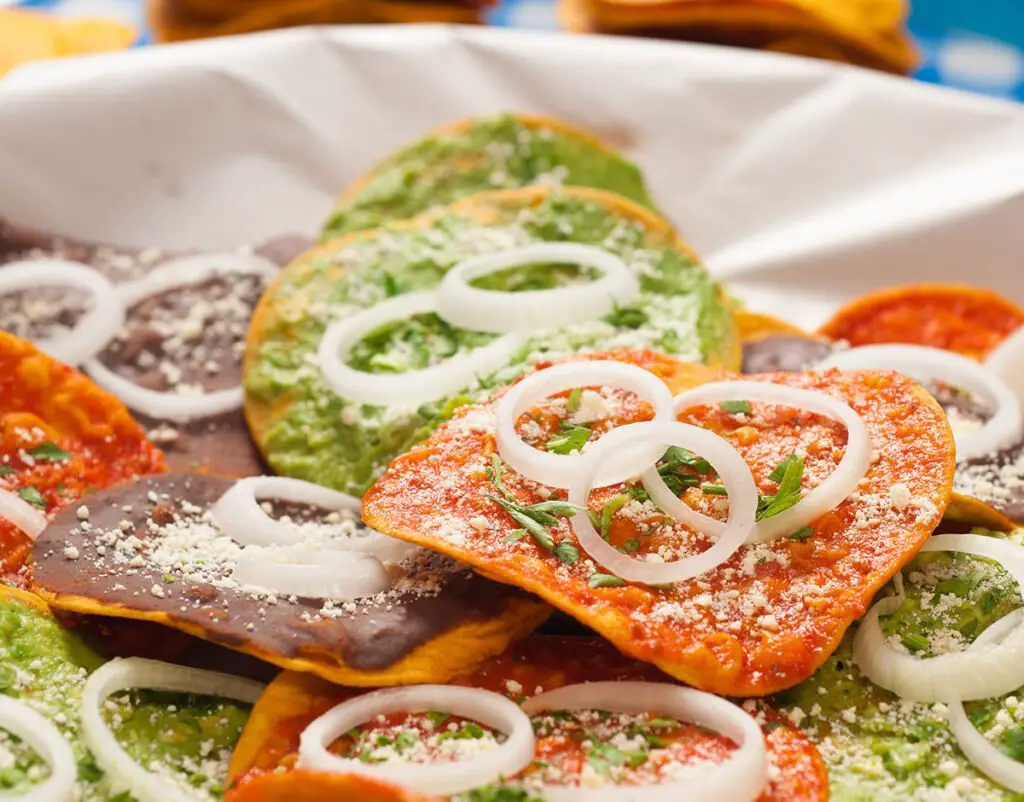
10 Fascinating Facts about Guatemala
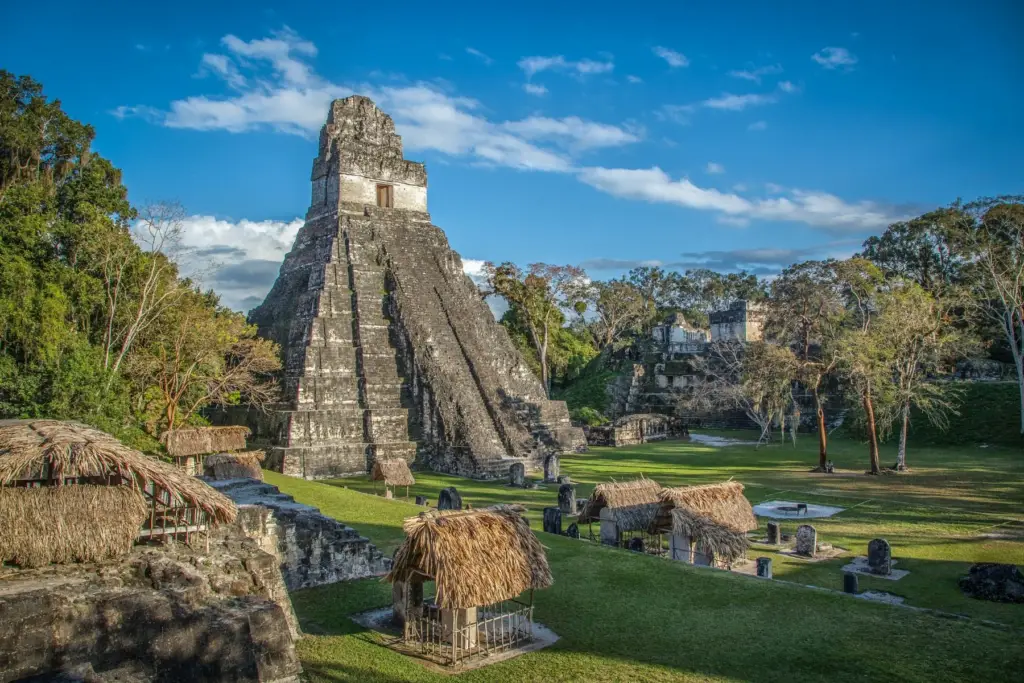
Guatemala, the “Land of the Quetzal,” boasts more than just stunning landscapes and vibrant culture. Dive into this captivating Central American nation with 10 fascinating facts that are sure to surprise, intrigue, and maybe even disturb you:
Volcanic Playground
Home to 37 volcanoes, Guatemala is a land of fiery giants. Three of these are even active, including the majestic Fuego, which puts on a fiery show with regular eruptions.
Birdwatching Paradise

With over 700 species, Guatemala boasts one of the most diverse bird populations in the world. Keep your eyes peeled for the national bird, the resplendent quetzal, with its emerald plumage and flowing tail feathers.
A Coffee Connoisseur’s Dream
Guatemalan coffee is world-renowned for its rich flavor and complex aroma. Volcanic soil and high altitudes create the perfect growing conditions for these aromatic beans.
A Mayan Marvel
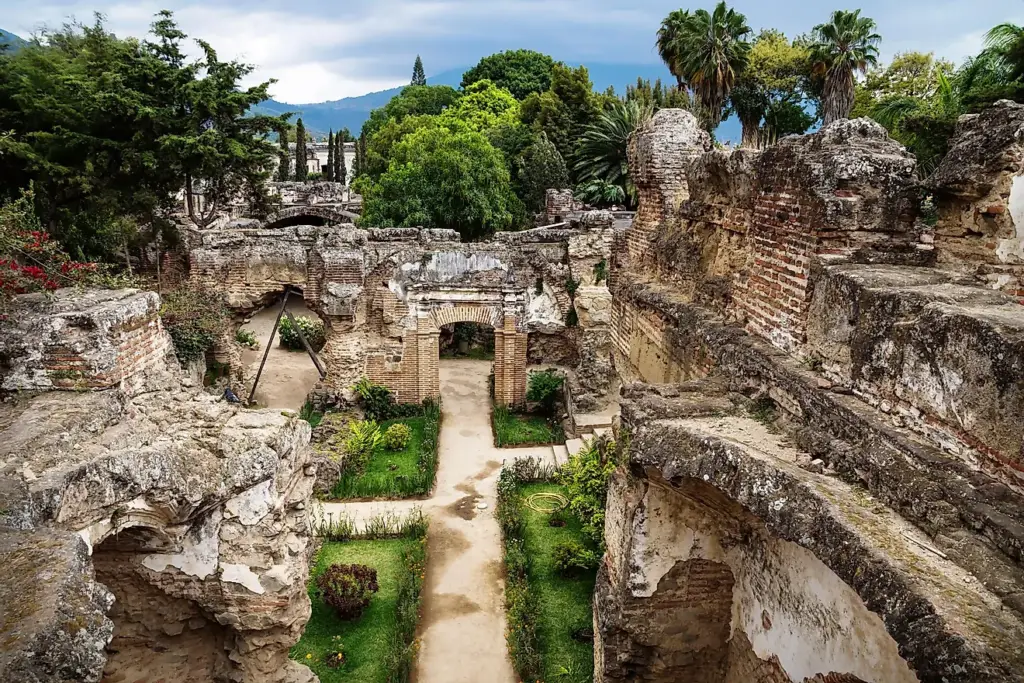
Guatemala is home to some of the most impressive Mayan ruins in the world, including the awe-inspiring Tikal, a sprawling complex hidden deep within the rainforest.
The Land of Eternal Spring
Guatemala enjoys a perpetual spring-like climate thanks to its high altitude and proximity to the equator. Pack light clothes and comfortable shoes, as the weather is perfect for exploring all year round.
The Birthplace of Chocolate

The history of chocolate can be traced back to the ancient Mayans, who used cocoa beans in their rituals and beverages. So, next time you indulge in a piece of chocolate, remember its Guatemalan roots!
A Multilingual Mosaic
Spanish is the official language, but Guatemala boasts a rich linguistic tapestry with over 20 Mayan languages spoken by various indigenous communities.
The Curious Case of the Jade Mask

The National Museum of Archaeology and Ethnology houses the famous jade death mask of King Pakal, the Mayan ruler who reigned in the 7th century. This intricate mask is a captivating example of Mayan artistry and craftsmanship.
A Festival for Every Occasion

Guatemalans love to celebrate! From the vibrant Flower Festival in February to the lively Giant Kite Festival in Sumpango, there’s always a reason to join in the festive spirit.
Beware of the “Cadejo”
According to Guatemalan folklore, two spirit dogs roam the streets at night—the white Cadejo representing good and the black Cadejo representing evil. While just a legend, it adds a touch of mystery to the Guatemalan nightscape.
These are just a few intriguing facts that scratch the surface of Guatemala’s rich tapestry. So, pack your bags, embrace the adventure, and discover the magic of this captivating land for yourself!
Guatemalan History and the Effect It Has Had on the Cuisine

Guatemala, a land steeped in rich history and vibrant culture, boasts a unique cuisine that reflects its fascinating past. Today, we embark on a delicious journey, exploring the key periods that shaped the flavors and traditions on every Guatemalan plate.
The Maya Legacy (2600 BC – 1697 AD)
The ancient Maya civilization laid the foundation for Guatemalan cuisine. Their sophisticated agricultural practices introduced staple foods like maize (corn), beans, and squash, which remain central ingredients to this day.
Imagine the ingenuity of this civilization, building grand cities while cultivating the very crops that would nourish generations to come.
The Spanish Influence (1524 onwards)

The Spanish conquest marked a new chapter. The capital, Antigua Guatemala, flourished, adopting aspects of Spanish culture. This influence brought new ingredients like wheat, rice, and livestock, along with innovative cooking techniques like frying and baking.
Guatemalan cuisine began to blossom, blending the vibrant flavors of the indigenous Maya with European influences.
Postcolonial Guatemala (1820s onwards)
After gaining independence in the 1820s, Guatemala navigated a complex path, experiencing periods of authoritarian rule and social unrest. Despite the political turmoil, traditional dishes remained a constant, offering comfort and a sense of cultural identity.
Street food vendors thrived, offering delicious snacks like tamales, chuchitos, and atol, a warm and comforting corn-based drink.
A Nation Divided (1931-1996)
This period witnessed political instability and a brutal civil war, leaving scars on the nation. Despite these hardships, traditional foods continued to be a source of solace and cultural connection.
Even amidst the chaos, the aroma of freshly made tamales and the comforting warmth of atol offered a sense of normalcy and hope.
Moving Towards Peace (21st Century)

Today, Guatemala strives for peace and reconciliation. Its cuisine continues to evolve, embracing both its indigenous roots and global influences.
Traditional dishes like pepián, a rich and flavorful stew, and tamalitos de chipilín, filled with the local herb chipilín, remain beloved staples, reminding everyone of their rich heritage.
A Bite of History
Guatemalan cuisine is a captivating story woven through time. Each ingredient, each dish, tells a tale of resilience, cultural exchange, and the enduring spirit of a nation. So, the next time you savor a Guatemalan dish, remember the fascinating journey it has taken to reach your plate.
References
How Guatemala’s Climate and Geography Have Influenced Guatemalan Cuisine
Guatemala, a tapestry of towering volcanoes, lush rainforests, and vibrant markets, boasts a cuisine as diverse as its landscape. Let’s explore how this nation’s unique location, climate, and geography have contributed to its culinary tapestry:
Volcanic Bounty

Guatemala’s fertile volcanic soil, nourished by abundant rain and a temperate climate, is a cornucopia of fresh ingredients. Imagine avocados so creamy they melt in your mouth (including the world-famous Hass variety), and cacao beans that yield some of the finest chocolate on Earth.
These, along with an array of fruits, spices, and grains, form the foundation of Guatemalan cuisine.
A Legacy of Flavor
The ancient Maya left an indelible mark on Guatemalan food. Their basic diet of corn, beans, squash, and cassava continues to be a staple, forming the base for countless dishes. Even the beloved cocoa drink, enjoyed by Mayan nobility, still finds its way onto modern Guatemalan tables.
A Fusion of Influences
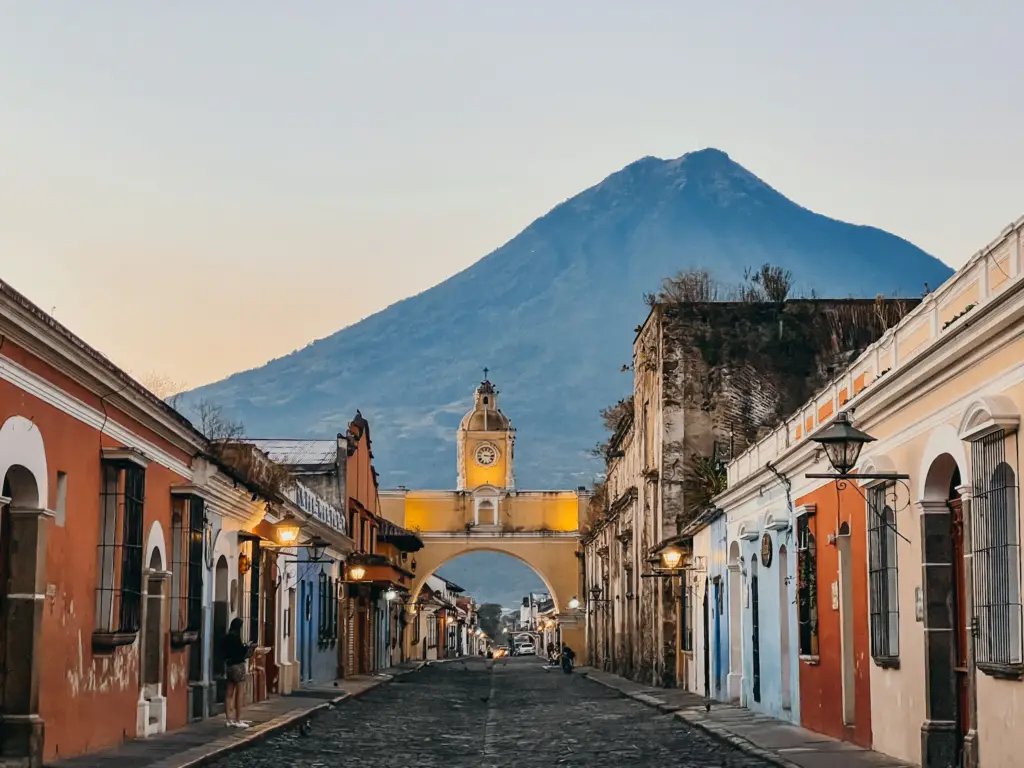



After the Spanish conquest, European ingredients and cooking techniques arrived, merging beautifully with indigenous traditions. This fusion is evident in dishes like tamales de elote (savory corn cakes), chiles rellenos (stuffed peppers), arroz con pollo (comforting chicken and rice), and the delightful flan for dessert.
A Journey Through Flavors
Guatemalan cuisine takes on unique flavors depending on the region:
- Highlands: Known for hearty stews, maize-based dishes, and the use of indigenous ingredients.
- Pacific Coast: A haven for seafood lovers, with coconut-infused dishes taking center stage.
- Petén: This tropical region boasts unique ingredients like chaya leaves, adding a surprising twist to local dishes.
- Antigua: This colonial city reflects a diverse culinary heritage, with influences from both Spanish and indigenous traditions.
From its volcanic soil to its rich cultural heritage, Guatemala’s geography has shaped a culinary landscape brimming with flavor and diversity. So, embark on your own culinary adventure and discover the unique taste of Guatemala!
References:
- Britannica: Guatemala – Culture, Traditions, Cuisine
- National Geographic: A Culinary Guide to Guatemala
- Environment and Development Economics: Climate Risk and Food Availability in Guatemala
- Together Women Rise: Customs & Cuisine of Guatemala
Understanding the Essence of Guatemalan Cuisine
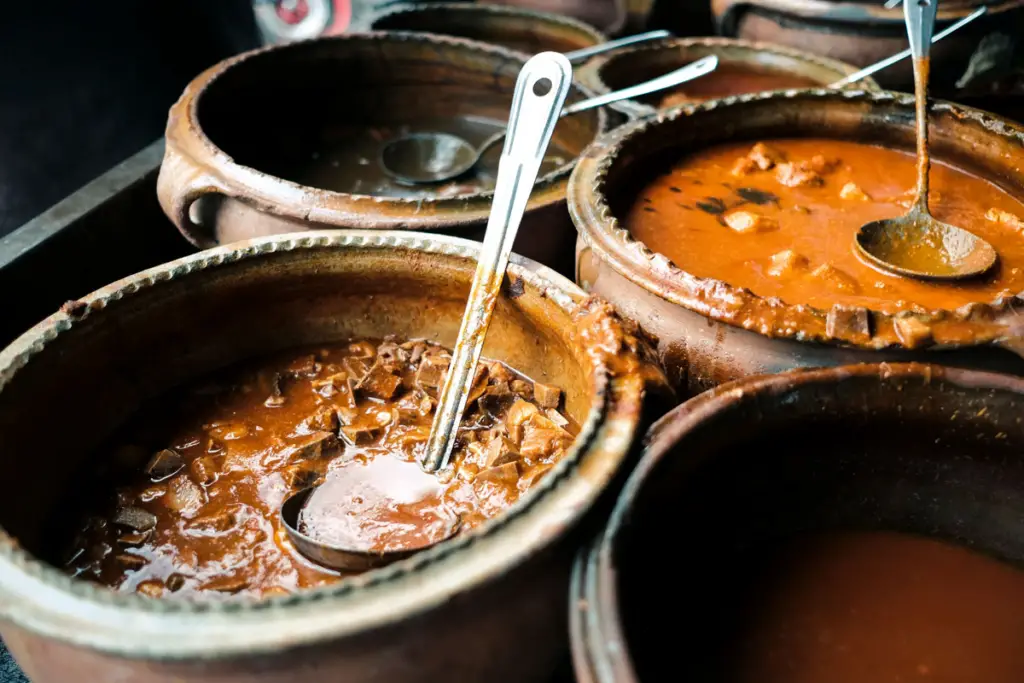
Guatemalan cuisine is a captivating dance of vibrant flavors, a vibrant tapestry woven with ancient Mayan traditions, Spanish influences, and the unique touch of its volcanic soil. But what truly sets it apart?
What makes this culinary experience so distinct and captivating?
A Fusion of Legacy and Innovation:
Guatemalan cuisine is more than just a collection of dishes; it’s a story whispered through generations. The foundation lies in the ancient Mayan staples: corn (a versatile ingredient used in everything from tortillas to tamales), beans, squash, and chili peppers.
These elements form the base for countless dishes, each adding a unique twist and showcasing the creativity of Guatemalan cooks.
The Spanish Kiss
The arrival of the Spanish in the 16th century brought a wave of new ingredients like wheat, rice, and livestock, along with innovative cooking techniques like frying and baking.
This cultural exchange led to a beautiful fusion, evident in dishes like chiles rellenos (stuffed peppers) and flavorful stews like pepián, where meat simmers in a rich and complex sauce.
Volcanic Bounty
Guatemala’s unique geography plays a crucial role in shaping its cuisine.
The fertile volcanic soil, nourished by abundant rainfall and a temperate climate, creates a cornucopia of fresh ingredients. Imagine avocados so creamy they melt in your mouth, and unique spices like achiote and chipilin adding depth and complexity to dishes.
A Journey Through Regions
Guatemalan cuisine isn’t monolithic. Each region boasts its own distinct flavors:
- The Highlands: Known for hearty stews like estofado (beef stew) and atol (a warm, corn-based beverage), reflecting the cooler climate and indigenous influences.
- The Pacific Coast: A haven for seafood lovers, where coconut milk infuses dishes with a tropical touch, evident in dishes like pescado en coco (fish in coconut sauce).
- The Petén Rainforest: This region boasts unique ingredients like chaya leaves, adding a surprising twist to local dishes.
More Than Just Food
Food in Guatemala is deeply intertwined with culture and tradition. From the vibrant fiambre (a cold cut and vegetable salad) enjoyed on All Saints’ Day to the street food vendors offering delicious snacks like chuchitos (similar to tamales), every bite tells a story and connects you to the rich heritage of the nation.
The Enchanting Difference
So, what makes Guatemalan cuisine so different? It’s the exquisite blend of ancient and modern, the unique touch of volcanic soil, the regional variations, and the deep connection to culture and tradition. It’s a cuisine that tantalizes the taste buds, warms the soul, and offers a captivating glimpse into the heart of Guatemala.
Embrace the adventure, embark on a culinary journey, and discover the essence of Guatemalan cuisine!
Guatemalan Culinary Traditions
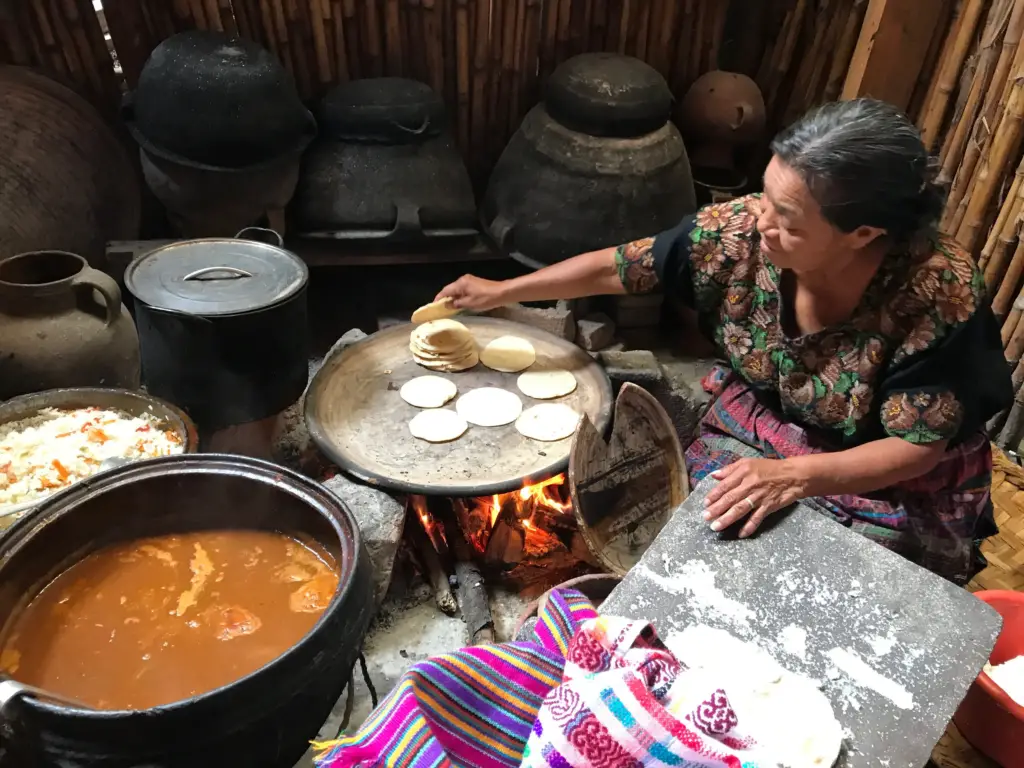
Guatemalan cuisine is a captivating tapestry woven with vibrant flavors, a testament to the rich history and diverse cultures that have shaped this Central American nation.
From ancient Mayan rituals to modern-day street food vendors, every bite tells a story, waiting to be savored and understood. Let’s embark on a delicious journey, exploring the unique traditions that define Guatemalan culinary experiences:
A Legacy of Corn
The journey begins with corn (maize), which has been the cornerstone of Guatemalan cuisine for millennia. The Maya, the first inhabitants of this land, revered corn as a sacred gift from the gods, utilizing it in their everyday meals and religious ceremonies.
Today, corn remains central to the Guatemalan diet, appearing in countless forms, from fluffy tortillas and tamales to atole, a comforting and versatile corn-based beverage.
Spanish Influence and Fusion
The arrival of the Spanish in the 16th century marked a new chapter. European ingredients like wheat, rice, and livestock were introduced, blending with indigenous traditions to create a flavorful fusion.
This influence is evident in popular dishes like chiles rellenos (stuffed peppers) and pepián, a rich stew where meat simmers in a complex sauce flavored with achiote, a vibrant red condiment derived from annatto seeds.
Regional Delights
Guatemalan cuisine isn’t monolithic. Each region boasts its own distinct flavors, reflecting the diverse geography and cultural influences:
- The Highlands: Nestled in the mountains, this region offers hearty stews like estofado (beef stew) and jocón (a green chicken stew) alongside warming beverages like atol de elote (corn atol).
- The Pacific Coast: Seafood takes center stage here, with dishes like pescado en coco (fish in coconut sauce) and ceviche (marinated seafood) reflecting the region’s tropical climate and proximity to the ocean.
- The Petén Rainforest: This lush region offers unique ingredients like chaya leaves and xa te (a type of palm heart), adding a surprising twist to local dishes.
Celebrating with Food
Food in Guatemala is deeply intertwined with cultural celebrations and traditions. During Semana Santa (Holy Week), families gather to enjoy traditional dishes like barbacoa (slow-cooked meat) and casamiento (rice and beans).
On All Saints’ Day, vibrant parades and giant kites take flight, while families share fiambre, an elaborate cold cut and vegetable salad.
Beyond the Plate
Guatemalan culinary traditions extend beyond the ingredients and dishes themselves. Traditional cooking methods, like using comales (griddles) and pibil (cooking food underground in banana leaves), are still practiced in many regions, adding an authentic touch to the experience.
A Taste of History and Culture
Guatemalan culinary traditions offer a window into the nation’s rich history and diverse cultures. Each bite is a journey through time, connecting you to the ancient Maya, the Spanish influences, and the unique regional flavors.
These continue to evolve and captivate the hearts (and taste buds) of food enthusiasts worldwide.
Exploring Guatemala’s Ingredients: The Flavors of Guatemalan Cuisine

From the ancient wisdom of the Maya to the fertile embrace of volcanic soil, each element contributes to the symphony of flavors that defines this Central American culinary experience.
Let’s embark on a delicious exploration, dissecting the key ingredients that orchestrate this culinary masterpiece:
The Enduring Legacy: Corn (Maize)
Corn, or maize, serves as the undisputed maestro of Guatemalan cuisine. Revered by the Maya as a sacred gift from the gods, corn has been a staple for millennia [^1]. Its versatility knows no bounds, taking center stage in countless forms:
- Tortillas: The foundation of many dishes, these thin, flatbreads are made from corn dough and cooked on a comal (griddle).
- Tamales: These savory pockets, wrapped in banana leaves or corn husks, are filled with various ingredients like meat, vegetables, or cheese.
- Atole: This warm and comforting beverage, made from cornmeal and often flavored with fruits, spices, or chocolate, is a beloved staple for breakfast or as a snack.
A Touch of Europe: Spanish Influence
The arrival of the Spanish in the 16th century introduced a new wave of ingredients, adding a distinct harmony to the symphony. These newcomers included:
- Wheat: Used for making bread, pastries, and empanadas.
- Rice: A common accompaniment to main dishes, often cooked with vegetables or meat.
- Livestock: Introduced cows, pigs, and chickens, adding protein variety to the Guatemalan diet.
- Spices: Garlic, onions, and other spices like cumin and coriander added depth and complexity to dishes.
Volcanic Bounty: A Gift from the Earth
Guatemala’s unique geography plays a crucial role in shaping its ingredients. The fertile volcanic soil, nourished by abundant rainfall and a temperate climate, creates a cornucopia of fresh and flavorful elements:
- Avocados: Guatemala is the birthplace of the Hass avocado, known for its creamy texture and rich flavor.
- Cacao Beans: Renowned for their quality, Guatemalan cacao beans are used to create some of the world’s finest chocolate.
- Spices: Achiote, a vibrant red condiment derived from annatto seeds, adds a distinctive touch to many dishes. Chipilin, a local herb with a slightly peppery taste, is another unique ingredient.
Regional Variations: A Tapestry of Flavors
Guatemalan cuisine is not a homogenous experience. Each region boasts its own distinct ingredients, reflecting the diverse geography and cultural influences:
- The Highlands: Known for its cooler climate and indigenous influences, this region features ingredients like chipilin, xate (a type of palm heart), and various mushrooms.
- The Pacific Coast: With its proximity to the ocean, seafood takes center stage, with ingredients like fresh fish, shrimp, and coconut milk.
- The Petén Rainforest: This lush region offers unique ingredients like chaya leaves, known for their high protein content, and various tropical fruits.
Beyond the Plate: Traditional Cooking Techniques
The experience goes beyond just the ingredients. Traditional cooking methods like pibil (cooking underground in banana leaves) and using comales (griddles) add an authentic touch to Guatemalan cuisine, further enriching the culinary journey.
A Symphony Awaits
Guatemalan food ingredients are like a vibrant orchestra, each element playing its part to create a truly captivating culinary experience. From the ancient legacy of corn to the unique touch of volcanic soil and the diverse regional variations, every bite tells a story waiting to be savored and understood.
So, embark on your own delicious adventure and discover the symphony of flavors that awaits you in Guatemala!
Mastering Guatemalan Cuisine Cooking Techniques

But beyond the vibrant ingredients lies another essential element: the art of cooking. Mastering these unique techniques is the key to unlocking the true magic of Guatemalan dishes in your own kitchen.
Embracing Tradition: Essential Cooking Methods
Guatemalan cooking methods are a captivating blend of ancient wisdom and modern ingenuity. Here are some key techniques to master:
- The Comal: This flat griddle, traditionally made of volcanic rock, is a cornerstone of Guatemalan kitchens. Used for cooking tortillas, grilling vegetables, and searing meats, the comal imparts a unique smoky flavor and texture to dishes.
- Pibil: This ancient Mayan technique involves wrapping food in banana leaves and cooking it underground in a pit lined with hot stones. The result is incredibly flavorful and tender meats, imbued with the earthy aroma of the leaves.
- Recaudo: This versatile sauce forms the base for many stews and soups. Made with a vibrant blend of tomatoes, chiles, achiote (a red condiment), and spices, it adds depth and complexity to any dish.
- Lixiado: This slow-cooking method involves simmering ingredients in a flavorful broth. Often used for preparing stews like pepián (a rich stew with meat and vegetables) and jocón (a green chicken stew), it allows the flavors to meld beautifully.
Mastering the Art: Essential Skills
Beyond specific techniques, mastering Guatemalan cuisine involves honing some crucial skills:
- Grinding: Traditionally, ingredients like corn and spices were ground using a mano y metate (a stone mortar and pestle). While modern kitchens can utilize food processors, mastering the art of grinding by hand adds a touch of authenticity and allows for finer control over texture.
- Building Layers of Flavor: Guatemalan cuisine is known for its complex and layered flavors. Mastering the art of sautéing, simmering, and layering ingredients is crucial for achieving the depth and richness that defines this cuisine.
- Balancing Spice: Chiles are a staple ingredient in Guatemalan cooking, adding heat and flavor. Learning to balance the heat with other flavors like sweet, sour, and savory is key to creating harmonious and enjoyable dishes.
Beyond Technique: Embracing the Culture
Mastering Guatemalan cuisine is not just about the technical aspects; it’s about embracing the cultural context as well. Understanding the history, traditions, and significance behind each dish adds a deeper layer of appreciation to the culinary experience.
Unlocking the Flavors
With dedication and a willingness to learn, you can unlock the secrets of Guatemalan cooking techniques. From mastering the smoky magic of the comal to building layers of flavor with recaudo, each step is a journey into the vibrant heart of this culinary tradition. So, embrace the adventure, gather your ingredients,
Guatemala National Dish

The Guatemala national dish, known as “Pepián,” is a flavorful and traditional stew that represents the rich culinary heritage of the country. This hearty dish is made by simmering a variety of ingredients including chicken or beef, vegetables, herbs, and spices, resulting in a delicious and aromatic meal.
The flavors of Pepián are complex, with hints of chili peppers, pumpkin seeds, and garlic, giving it a unique and distinct taste. It is often served with rice and tortillas, and is enjoyed by locals and visitors alike as a true taste of Guatemala.
Traditional Guatemalan Food

Traditional Guatemalan food is renowned for its vibrant flavors and unique combination of ingredients. The rich cultural heritage of Guatemala is reflected in its cuisine, which consists of a variety of dishes that have been passed down through generations.
From the staple dish of black beans and rice, known as “gallo pinto,” to the mouthwatering tamales wrapped in banana leaves, traditional Guatemalan food offers a delicious journey into the country’s culinary traditions.
The use of local ingredients such as corn, tomatoes, avocados, and chiles add a burst of freshness and spice to the dishes, making them a true delight for the senses.
Exploring Guatemalan Street Food
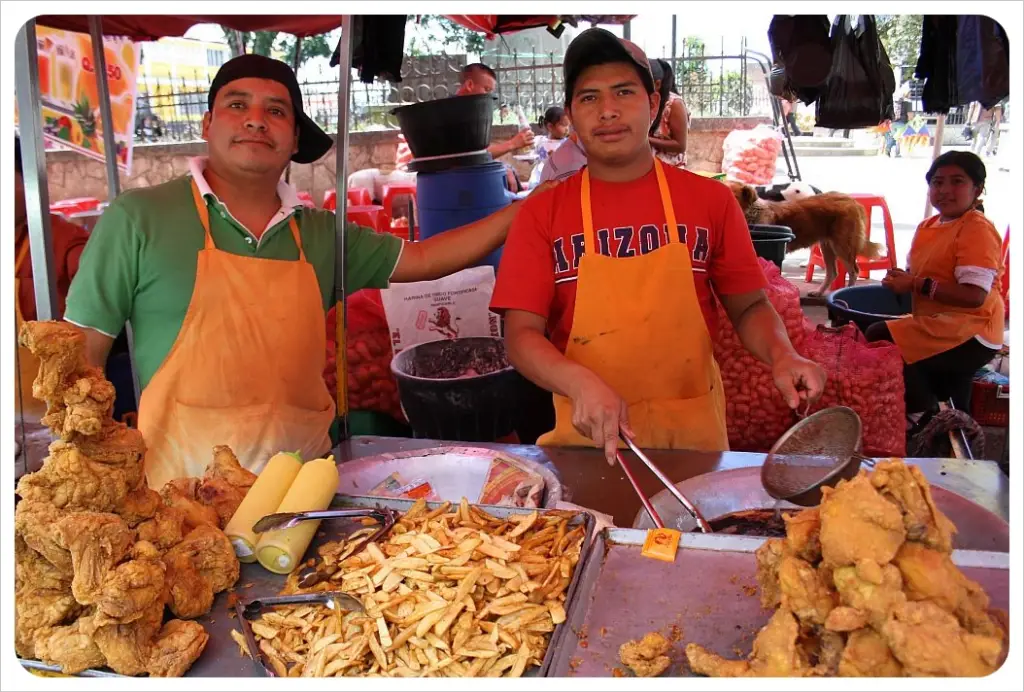
When it comes to experiencing the vibrant food culture of Guatemala, the street food scene is a must-try. From bustling markets to street vendors, the mouthwatering aromas and bright colors are bound to entice you.
One of the most famous street foods in Guatemala is the tostada, which is a crisp fried tortilla topped with refried beans, shredded lettuce, cheese, salsa, and your choice of meat. It’s a perfect snack to carry around while exploring the bustling streets of Guatemala City or Antigua.
Another popular street food is the chuchito, which is a small, steamed tamale filled with chicken, pork, or beef and a savory tomato sauce. Akin to Mexican tamales, chuchitos are ubiquitous in Guatemala and are perfect for a quick snack to fuel you up on the go.
The elote loco is another street food that’s a must-try. They cook a whole corn on the cob then slather it with mayonnaise, cheese, and chili powder. It’s a surprisingly delicious combination of flavors and textures.
If you’re feeling adventurous, you can try the caldo de cabeza, a soup made from the head of a cow or pig. They flavor it with garlic, onion, and chili and often serve it with corn tortillas and lime wedges.
Finally, don’t forget to try the tamales, a traditional dish found across Central and South America. In Guatemala, they come in many flavors, from sweet to savory, and are made with a maize dough that’s stuffed with meat, sauce, or cheese and then wrapped in banana leaves.
The Most Popular Guatemalan Recipes

From hearty stews to fresh seafood delights, each bite tells a story waiting to be savored. If you’re ready to embark on a delicious journey, here are 10 of the most popular Guatemalan recipes that will tantalize your taste buds:
Pepián
This rich and flavorful stew is a Guatemalan classic. Traditionally featuring chicken, vegetables, and a complex sauce made with tomatoes, chiles, achiote (a vibrant red condiment), and spices, pepián is a true celebration of Guatemalan culinary heritage.
Tamales
These savory pockets, wrapped in banana leaves or corn husks, are a staple in Guatemalan cuisine. Filled with various ingredients like chicken, pork, vegetables, or cheese, tamales offer a delicious and portable option for any meal.
Chiles Rellenos
These colorful stuffed peppers are a delightful combination of sweet and savory flavors. Poblano peppers are filled with a delicious blend of meat, vegetables, and cheese, then dipped in batter and fried until golden brown.
Jocón
This green chicken stew is a specialty of the Guatemalan highlands. Featuring tender chicken simmered in a vibrant green sauce made with tomatillos, cilantro, and spices, jocón offers a burst of fresh flavor with every bite.
Ceviche
This refreshing seafood dish is a perfect way to experience the bounty of the Pacific Coast. Fresh fish or shrimp are marinated in citrus juices, onions, chilies, and spices, resulting in a light and flavorful dish often served with tostadas and fresh avocado.
Atol
This warm and comforting beverage is a beloved staple in Guatemala. Made from cornmeal and often flavored with fruits, spices, or chocolate, atol is enjoyed for breakfast, as a snack, or even as a dessert.
Fiambre
This cold cut and vegetable salad is a unique and colorful dish traditionally enjoyed on All Saints’ Day. Featuring a variety of meats, cheeses, vegetables, and pickled ingredients, fiambre is a vibrant and flavorful expression of Guatemalan culinary creativity.
Rellenitos de Plátano
These fried plantain pockets are a popular street food found throughout Guatemala. Mashed plantains are filled with savory black beans, then fried until crispy, offering a delicious and satisfying snack or side dish.
Horchata
This refreshing beverage is a perfect way to cool down on a hot day. Made with rice, milk, cinnamon, and sometimes chocolate, horchata offers a sweet and slightly nutty flavor with a creamy texture.
Kak’ik
This flavorful turkey soup is a specialty of Guatemala’s western highlands. Featuring a rich and savory broth with vegetables, spices, and tender turkey, kak’ik is a comforting and satisfying dish often enjoyed during celebrations.
These 10 recipes are just a glimpse into the vast and vibrant world of Guatemalan cuisine. Each dish offers a unique flavor profile and cultural significance, waiting to be explored and enjoyed. So, embark on your own delicious adventure and discover the magic of Guatemalan food!
What are the Health Implications of Guatemalan Cuisine?
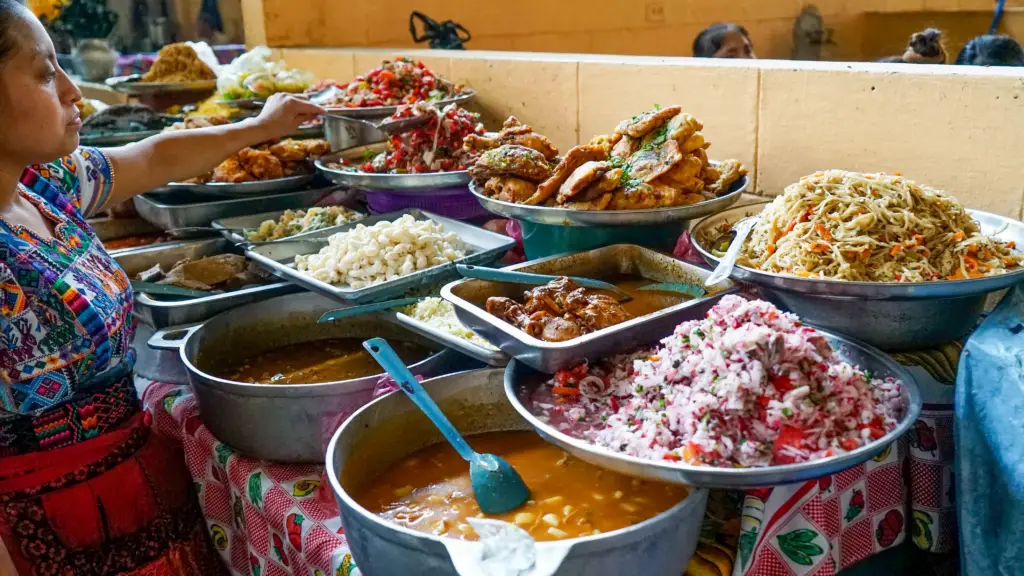
Guatemalan cuisine is a captivating tapestry woven with ancient Mayan traditions and vibrant Spanish influences. Let’s embark on a journey to explore this culinary landscape, its connection to health, and its impact on the national population.
A Balancing Act: Health and Cuisine
Guatemalan cuisine offers a treasure trove of ingredients with potential health benefits:
- Beans, Corn, and Chilies: These staples form the foundation of many dishes. Beans are a powerhouse of protein and fiber, while corn is packed with vitamins and minerals. Chilies, with their vibrant kick, may offer additional health benefits due to capsaicin, a compound with various potential health properties.
- Avocados: Guatemala is the birthplace of the beloved Hass avocado, a fruit overflowing with nutrients. Avocados are a rich source of healthy fats, fiber, and essential vitamins].
- Chocolate: The Mayans weren’t wrong! Chocolate, specifically dark chocolate in moderation, has been linked to potential cardiovascular benefits.
Navigating Challenges: Population Health
Despite the potential health benefits of certain ingredients, Guatemala faces unique challenges:
- Morbidity: The nation grapples with infectious diseases, malnutrition, and maternal mortality. Additionally, non-communicable diseases (NCDs) like diabetes, cardiovascular diseases, and high cholesterol are prevalent.
- Diabetes: The prevalence of diabetes is on the rise, likely due to a combination of factors like unhealthy dietary choices, lack of physical activity, and genetic predisposition.
- Cardiovascular Health: High rates of hypertension and heart disease highlight the need for lifestyle changes and improved access to healthcare.
- High Cholesterol: Dietary patterns high in fried foods and processed meats may contribute to elevated cholesterol levels, emphasizing the importance of mindful choices.
Guatemalan cuisine is a vibrant celebration of tradition, offering a delightful culinary adventure. However, like any cuisine, balance and moderation are key. While indulging in the unique flavors, remember to be mindful of overall health and seek a balanced approach to maximize the benefits offered by this captivating culinary landscape.
References
- Health in the Americas profile for Guatemala
- foreignfork.com
- hia.paho.org
- data.who.int
- sciencedaily.com
- globalheartjournal.com
- heart.org
- en.wikipedia.org
- dominicanabroad.com
A Kaleidoscope of Flavors: Guatemalan Food Specialties to try at Home
Guatemala’s food specialties are a delightful blend of indigenous Mayan, Spanish, and African flavors. With its diverse range of ingredients and spices, Guatemalan cuisine is a true gastronomic kaleidoscope that never fails to tantalize the taste buds.
One of the most famous Guatemalan food specialties is the chiles rellenos. These are stuffed peppers filled with meat or cheese and then deep-fried until crispy. The chiles rellenos are often served with tomato sauce and white rice, making it a perfect comfort food.
Guatemalan Food – Pollo Guisado

History and Background
Embark on a culinary journey through the vibrant and diverse flavors of Guatemala with Pollo Guisado, a cherished dish that reflects the country’s rich cultural tapestry. Originating from the indigenous Mayan traditions and influenced by Spanish culinary techniques, Pollo Guisado holds a special place in Guatemalan kitchens.
This hearty stew, featuring tender chicken and an array of vegetables, is not just a meal; it’s a celebration of Guatemala’s culinary heritage.
Guatemalan Food – Pollo Guisado Ingredients
Immerse yourself in the authentic flavors of Guatemalan Pollo Guisado with these ingredients:
- 2 lbs chicken, cut into pieces
- 2 tablespoons vegetable oil
- 1 onion, finely chopped
- 3 cloves garlic, minced
- 1 bell pepper, diced
- 2 tomatoes, chopped
- 1 carrot, peeled and sliced
- 1 potato, peeled and diced
- 1 cup green beans, trimmed and chopped
- 2 cups chicken broth
- 1 teaspoon ground cumin
- 1 teaspoon dried oregano
- 1 bay leaf
- Salt and pepper to taste
- Fresh cilantro for garnish
Guatemalan Food – Pollo Guisado Recipe
1. Sear the Chicken
- Heat vegetable oil in a large pot and sear the chicken pieces until golden brown.
2. Saute Aromatics
- Add chopped onions and minced garlic, sautéing until fragrant.
3. Add Vegetables
- Toss in diced bell peppers, chopped tomatoes, sliced carrots, diced potatoes, and chopped green beans.
4. Season the Stew
- Sprinkle ground cumin, dried oregano, salt, and pepper over the ingredients for a flavorful blend.
- Introduce a bay leaf to enhance the aroma.
5. Pour in Chicken Broth
- Pour chicken broth into the pot, ensuring the ingredients are well-submerged.
6. Simmer to Perfection
- Cover the pot and let the stew simmer on low heat for 30-40 minutes, allowing the flavors to meld.
7. Garnish and Serve
- Garnish with fresh cilantro before serving to add a burst of freshness.
Serving and Nutritional Information
This Guatemalan Pollo Guisado recipe serves approximately 4-6 people and takes around 1 hour to prepare. Each serving is estimated to be around 350 calories, making it a wholesome and nutritious choice.
Savor the warmth and heartiness of Guatemala with this delightful Pollo Guisado. So, gather around, relish the flavors, and celebrate the cultural richness of Guatemala at your table!
Guatemalan Food – Jocón

History and Background
Embark on a culinary journey to Guatemala, where each bite of Jocón tells a story of ancient Mayan traditions blended with the colonial influence. Hailing from the region of Cobán, Jocón is a flavorful chicken stew enriched with vibrant green ingredients.
Traditionally made in a clay pot, this dish showcases Guatemala’s lush landscapes, cultural diversity, and the warmth of its people.
Guatemalan Food – Jocón Ingredients
Prepare to immerse yourself in the rich flavors of Guatemalan Jocón with these authentic ingredients:
- 2.5-3 pounds chicken, cut into pieces
- 1 bunch fresh cilantro, stems included
- 1 bunch fresh mint leaves
- 1 medium-sized green bell pepper, chopped
- 1 medium-sized yellow onion, chopped
- 5 cloves garlic, minced
- 3 medium-sized tomatillos, husked and chopped
- 2 medium-sized tomatoes, chopped
- 1 teaspoon ground cumin
- 1 teaspoon ground achiote (annatto)
- 1 tablespoon vegetable oil
- Salt and pepper to taste
- 4 cups chicken broth
- 2 tablespoons corn masa (optional, for thickening)
Guatemalan Food – Jocón Recipe
1. Blend the Greens
- In a blender, combine cilantro, mint, green bell pepper, onion, garlic, tomatillos, and tomatoes. Blend until you get a smooth, vibrant green sauce.
2. Sauté and Season
- In a large pot, heat vegetable oil over medium heat.
- Add ground cumin and achiote, stirring for a minute until fragrant.
- Add the chicken pieces and brown them on all sides.
- Season with salt and pepper.
3. Add the Green Sauce
- Pour the blended green sauce over the browned chicken, ensuring it’s well-coated.
- Stir in chicken broth and bring to a gentle boil.
4. Simmer to Perfection
- Reduce the heat to low, cover the pot, and let it simmer for about 45-60 minutes until the chicken is tender and cooked through.
5. Optional Thickening
- If desired, mix corn masa with a small amount of water to create a paste. Stir it into the stew to thicken.
6. Serve and Enjoy
- Serve Jocón hot, accompanied by rice or tortillas. Garnish with additional fresh herbs if desired.
Serving and Nutritional Information
This Jocón recipe serves approximately 6 people and takes around 1 hour to prepare. Each serving is estimated to be around 300 calories, offering a satisfying balance of protein and vibrant greens. Dive into the heart of Guatemala with this aromatic Jocón, a dish that captures the essence of the country’s culinary heritage. So, gather around the table, share the warmth, and savor the flavors of Guatemalan Jocón!
Guatemalan Food – Ceviche

History and Background
Embark on a coastal adventure through the flavors of Guatemala with Ceviche, a dish that mirrors the vibrant culture and abundance of the country’s Pacific coastline. Originating from the fusion of indigenous Mayan ingredients and the influence of Spanish conquistadors, Guatemalan Ceviche is a testament to the country’s culinary diversity.
The freshness of seafood, combined with zesty lime and native spices, creates a dish that captures the essence of Guatemala’s coastal regions.
Guatemalan Food – Ceviche Ingredients
Delight in the coastal freshness of Guatemalan Ceviche with these authentic ingredients:
- 1 pound white fish fillets, diced
- 1/2 pound shrimp, peeled and deveined
- 1 cup fresh lime juice
- 1 cup diced tomatoes
- 1/2 cup finely chopped red onion
- 1/2 cup chopped fresh cilantro
- 2 jalapeño peppers, seeded and finely chopped
- 1 avocado, diced
- Salt and pepper to taste
- Tortilla chips for serving
Guatemalan Food – Ceviche Recipe
1. Prepare the Seafood
- In a bowl, combine diced fish and shrimp.
- Pour fresh lime juice over the seafood, ensuring it’s well-coated. Let it marinate for about 15-20 minutes.
2. Dice and Chop Fresh Ingredients
- While the seafood marinates, dice tomatoes, red onion, cilantro, jalapeños, and avocado.
3. Combine Ingredients
- After marinating, drain excess lime juice from the seafood.
- In a large bowl, combine the marinated seafood with diced tomatoes, red onion, cilantro, jalapeños, and diced avocado.
4. Season to Perfection
- Season the ceviche with salt and pepper to taste. Adjust lime juice if needed for your preferred level of acidity.
5. Chill and Serve
- Refrigerate the ceviche for at least 30 minutes to let the flavors meld and the seafood fully “cook” in the lime juice.
- Serve chilled, accompanied by tortilla chips.
Serving and Nutritional Information
This Guatemalan Ceviche recipe serves approximately 4 people and takes around 30 minutes to prepare. Each serving is estimated to be around 200 calories, offering a refreshing and low-calorie seafood delight. Dive into the coastal freshness of Guatemala with this zesty Ceviche, perfect for a light meal or a refreshing appetizer. So, plate up, share the goodness, and savor the flavors of Guatemalan Ceviche by the seaside!
Guatemalan Food – Atol

History and Background
Embark on a journey into the heart of Guatemala’s rich culinary tapestry with Atol, a warm and comforting beverage deeply rooted in Mayan traditions. Originating from the pre-Columbian era, Atol has evolved into a beloved Guatemalan drink, especially during celebrations and cool evenings.
This hearty, thickened drink, often infused with cinnamon and cocoa, reflects the country’s indigenous heritage and the resilience of its people.
Guatemalan Food – Atol Ingredients
Warm your soul with the authentic flavors of Guatemalan Atol using these traditional ingredients:
- 1 cup masa harina (corn flour)
- 4 cups water
- 1 cup milk
- 1 cinnamon stick
- 1 cup brown sugar (adjust to taste)
- 1 teaspoon vanilla extract
- Ground cinnamon for garnish
Guatemalan Food – Atol Recipe
1. Prepare Masa Base
- In a bowl, mix masa harina with 2 cups of water, creating a smooth paste.
2. Cook Masa Base
- In a pot, bring the remaining 2 cups of water to a gentle boil.
- Gradually whisk the masa paste into the boiling water, ensuring there are no lumps.
3. Infuse with Cinnamon
- Add a cinnamon stick to the pot, infusing the mixture with warm, aromatic flavors.
- Let the mixture simmer for about 10-15 minutes, stirring occasionally.
4. Incorporate Milk and Sweeten
- Pour in the milk and stir well, creating a creamy consistency.
- Add brown sugar to sweeten the Atol, adjusting to your preferred level of sweetness.
5. Finish with Vanilla
- Stir in vanilla extract, enhancing the drink with a subtle, sweet fragrance.
6. Simmer to Perfection
- Let the Atol simmer on low heat for an additional 10 minutes, allowing the flavors to meld.
7. Serve Warm and Garnish
- Remove the cinnamon stick from the pot.
- Pour the warm Atol into mugs, sprinkle with ground cinnamon for garnish.
Serving and Nutritional Information
This Guatemalan Atol recipe serves approximately 4 people and takes around 30 minutes to prepare. Each serving is estimated to be around 200 calories, providing a comforting blend of carbohydrates and warmth.
Experience the heartwarming traditions of Guatemala with this delicious Atol, perfect for chilly evenings or festive gatherings. So, cozy up, sip slowly, and savor the soul-soothing delight of Guatemalan Atol!
Guatemalan Food – Rellenitos De Plátano

History and Background
Embark on a sweet journey through Guatemala with Rellenitos de Plátano, a delightful treat deeply rooted in the country’s cultural tapestry. Originating from indigenous Mayan traditions, these stuffed plantains showcase the influence of both ancient and colonial ingredients.
As you savor each bite of these chocolate-filled delights, you’ll experience the fusion of Guatemala’s rich history, vibrant flavors, and the joyous spirit of its people.
Guatemalan Food – Rellenitos De Plátano Ingredients
Indulge in the sweet goodness of Guatemalan Rellenitos de Plátano with these authentic ingredients:
- 4 ripe plantains
- 1 cup black beans, cooked and mashed
- 1/2 cup brown sugar
- 1 teaspoon ground cinnamon
- 1/2 cup semisweet chocolate chips
- Vegetable oil for frying
- Pinch of salt
- Sesame seeds for garnish
Guatemalan Food – Rellenitos De Plátano Recipe
1. Prepare the Plantains
- Peel the ripe plantains and boil them until they are soft (about 15-20 minutes).
- Once boiled, mash the plantains in a bowl until smooth.
2. Sweeten the Plantain Mash
- Add brown sugar, ground cinnamon, and a pinch of salt to the mashed plantains. Mix well.
3. Form Plantain Discs
- Take a portion of the sweetened plantain mixture and flatten it into a disc in the palm of your hand.
4. Add Chocolate Filling
- Place a few chocolate chips in the center of the plantain disc.
- Fold the edges of the disc over the chocolate chips, forming a stuffed ball.
5. Seal and Shape
- Roll the stuffed ball in your hands to ensure it is sealed and shaped into a smooth, rounded form.
6. Fry to Perfection
- In a pan, heat vegetable oil over medium-high heat for frying.
- Fry the stuffed plantains until golden brown on all sides.
7. Drain and Garnish
- Remove the Rellenitos from the oil and drain excess oil on paper towels.
- Garnish with sesame seeds for added texture and visual appeal.
Serving and Nutritional Information
This Rellenitos de Plátano recipe serves approximately 4 people and takes around 45 minutes to prepare. Each serving is estimated to be around 250 calories, providing a delightful mix of carbohydrates and sweetness.
Enjoy the rich flavors of Guatemala with these chocolate-filled delights, perfect for dessert or a sweet snack. So, indulge your sweet tooth, share the joy, and savor the essence of Guatemalan Rellenitos de Plátano!
Guatemalan Food – Horchata

History and Background
Embark on a liquid journey through Guatemala with Horchata, a beverage that encapsulates the country’s rich culinary traditions. Originating from Spain and adapted into the heart of Guatemalan culture, Horchata is a refreshing and sweetened rice drink often enjoyed during celebrations and warm afternoons.
The infusion of cinnamon and vanilla in this beloved beverage mirrors the country’s warm hospitality and diverse cultural influences.
Guatemalan Food – Horchata Ingredients
Delight in the cool sweetness of Guatemalan Horchata with these authentic ingredients:
- 1 cup long-grain white rice
- 2 cinnamon sticks
- 4 cups water
- 1 cup milk
- 1/2 cup sugar (adjust to taste)
- 1 teaspoon vanilla extract
- Ground cinnamon for garnish
Guatemalan Food – Horchata Recipe
1. Rinse and Soak Rice
- Rinse the white rice under cold water until the water runs clear.
- Soak the rice and cinnamon sticks in 4 cups of water for at least 2 hours or overnight.
2. Blend Rice Mixture
- In a blender, combine the soaked rice, cinnamon sticks, and water. Blend until you get a smooth, milky consistency.
3. Strain the Mixture
- Strain the blended mixture using a fine mesh sieve or cheesecloth to extract the liquid. Discard the solids.
4. Sweeten and Flavor
- In the strained liquid, add milk, sugar, and vanilla extract. Stir well to dissolve the sugar.
5. Chill and Serve
- Refrigerate the Horchata for at least 2 hours to chill.
- Serve over ice, garnished with a sprinkle of ground cinnamon.
Serving and Nutritional Information
This Guatemalan Horchata recipe serves approximately 4 people and takes around 15 minutes to prepare. Each serving is estimated to be around 150 calories, offering a refreshing and low-calorie beverage.
Enjoy the cool embrace of Guatemala with this sweet Horchata, perfect for sipping on a warm day or complementing spicy dishes. So, pour a glass, relax, and savor the flavors of Guatemalan hospitality in every sip!
Guatemalan Food – Caldo De Cabeza

History and Background
Embark o this hearty soup is a celebration of communal cooking and the rich agricultural bounty of the region.
As you indulge in each spoonful, you’ll taste the warmth of Guatemala’s diverse landscapes and the resilience of its people.
Guatemalan Food – Caldo De Cabeza Ingredients
Dive into the heartiness of Guatemalan Caldo de Cabeza with these authentic ingredients:
- 1 beef or goat head, cleaned and halved
- 2 corn on the cob, cut into chunks
- 2 large potatoes, peeled and diced
- 2 carrots, peeled and sliced
- 1 chayote squash, peeled and diced
- 1 onion, finely chopped
- 3 cloves garlic, minced
- 1/2 cup rice
- 1/2 cup fresh cilantro, chopped
- Salt and pepper to taste
- Lime wedges for serving
Guatemalan Food – Caldo De Cabeza Recipe
1. Prepare the Head
- Clean the beef or goat head thoroughly, ensuring it’s halved and ready for cooking.
2. Simmer the Broth
- In a large pot, add the head halves and cover with water.
- Bring the water to a boil, then reduce the heat to a simmer and let it cook for at least 2 hours until the meat is tender.
3. Add Vegetables
- Once the meat is tender, add corn on the cob, potatoes, carrots, chayote squash, onion, and garlic to the pot.
4. Incorporate Rice
- Stir in rice, ensuring it’s evenly distributed in the soup.
5. Season and Simmer
- Season the soup with salt and pepper to taste.
- Let the soup simmer for an additional 30-45 minutes until all the vegetables and rice are fully cooked.
6. Garnish and Serve
- Just before serving, sprinkle fresh cilantro on top for added flavor.
- Serve hot with lime wedges on the side.
Serving and Nutritional Information
This Guatemalan Caldo de Cabeza recipe serves approximately 6 people and takes around 3 hours to prepare. Each serving is estimated to be around 350 calories, providing a wholesome blend of protein and vegetables.
Experience the heartiness of Guatemala with this comforting head soup, perfect for communal gatherings or chilly evenings. So, ladle it into bowls, share the warmth, and savor the flavors of Guatemalan tradition in every spoonful!
Guatemalan Food – Elote Loco

History and Background
Embark on a journey through the lively streets of Guatemala, where Elote Loco reigns as a beloved street food sensation. Originating from the bustling markets and vibrant celebrations, this dish encapsulates the essence of Guatemalan street food culture.
A flavorful fusion of grilled corn, creamy toppings, and a burst of spices, Elote Loco showcases Guatemala’s festive spirit and the love for bold, savory flavors.
Guatemalan Food – Elote Loco Ingredients
Indulge in the savory and zesty goodness of Guatemalan Elote Loco with these authentic ingredients:
- 6 ears of fresh corn, husked
- 1 cup mayonnaise
- 1 cup sour cream
- 1 cup cotija cheese, crumbled
- 1 teaspoon chili powder
- 1 teaspoon paprika
- Fresh cilantro, chopped
- Lime wedges for serving
Guatemalan Food – Elote Loco Recipe
1. Grill the Corn
- Preheat the grill to medium-high heat.
- Grill the husked corn, turning occasionally, until slightly charred and cooked through (about 10-15 minutes).
2. Prepare the Toppings
- In a bowl, mix mayonnaise and sour cream to create the creamy base.
- In a separate bowl, combine crumbled cotija cheese, chili powder, and paprika.
3. Coat the Corn
- Generously coat each grilled corn with the creamy mixture, ensuring an even layer.
4. Sprinkle Cheese Mixture
- Sprinkle the cotija cheese mixture over the creamy-coated corn, covering it entirely.
5. Garnish with Cilantro
- Sprinkle freshly chopped cilantro over the Elote Loco for a burst of freshness.
6. Serve with Lime Wedges
- Serve the Elote Loco hot, accompanied by lime wedges for an extra zing.
Serving and Nutritional Information
This Guatemalan Elote Loco recipe serves approximately 6 people and takes around 20 minutes to prepare. Each serving is estimated to be around 300 calories, providing a satisfying combination of grilled corn and savory toppings.
Experience the vibrant street food culture of Guatemala with this flavorful Elote Loco, perfect for outdoor gatherings or as a delightful snack. So, bite into the goodness, share the joy, and savor the flavors of Guatemalan street food delight!
Guatemalan Food – Gallo Pinto

History and Background
Start your day with the aromatic embrace of Guatemalan Gallo Pinto, a cherished breakfast staple deeply rooted in the country’s rich culinary traditions. Originating from a fusion of indigenous Mayan ingredients and the influence of Spanish colonizers, this dish reflects the cultural diversity and flavors of Guatemala.
As you savor each spoonful of this hearty mix of rice and beans, you’ll connect with the morning rituals of Guatemalan kitchens and the warmth of its people.
Guatemalan Food – Gallo Pinto Ingredients
Wake up to the flavors of Guatemala with these authentic Gallo Pinto ingredients:
- 2 cups cooked white rice, preferably day-old
- 1 cup black beans, cooked and drained
- 1/2 cup bell pepper, diced
- 1/2 cup onion, finely chopped
- 2 cloves garlic, minced
- 2 tablespoons vegetable oil
- 1 teaspoon ground cumin
- 1 teaspoon paprika
- Salt and pepper to taste
- Fresh cilantro for garnish
- Fried eggs for serving
Guatemalan Food – Gallo Pinto Recipe
1. Prepare Ingredients
- Ensure that the white rice and black beans are cooked and ready.
- Dice the bell pepper, finely chop the onion, and mince the garlic.
2. Sauté Aromatics
- In a large pan, heat vegetable oil over medium heat.
- Add chopped onion and minced garlic, sautéing until fragrant.
3. Add Bell Pepper and Beans
- Stir in diced bell pepper and cooked black beans, allowing them to cook together for 3-5 minutes.
4. Season with Spices
- Sprinkle ground cumin and paprika over the mixture, ensuring even distribution.
- Season with salt and pepper to taste.
5. Integrate Cooked Rice
- Add the day-old cooked white rice to the pan, gently folding it into the bean mixture.
6. Sauté to Perfection
- Allow the Gallo Pinto to sauté for an additional 5-7 minutes until flavors meld, and rice is heated through.
7. Garnish and Serve
- Garnish with fresh cilantro and serve hot, accompanied by fried eggs.
Serving and Nutritional Information
This Guatemalan Gallo Pinto recipe serves approximately 4 people and takes around 20 minutes to prepare. Each serving is estimated to be around 300 calories, offering a balanced blend of protein, fiber, and carbohydrates.
Kickstart your day with the wholesome goodness of Gallo Pinto, a breakfast tradition that captures the heart of Guatemala. So, plate up, savor the warmth, and relish the flavors of Guatemalan morning delight!
Guatemalan Food – Pescado En Coco

History and Background
Embark on a culinary journey to the lush landscapes of Guatemala with Pescado en Coco, a dish that encapsulates the coastal flavors and cultural vibrancy of the region. Originating from the Caribbean-influenced areas, this coconut fish stew showcases the perfect marriage of fresh seafood and aromatic coconut milk.
As you savor the fragrant and savory broth, you’ll connect with Guatemala’s coastal traditions and the zest for life found along its sun-kissed shores.
Guatemalan Food – Pescado En Coco Ingredients
Dive into the tropical delights of Guatemalan Pescado en Coco with these authentic ingredients:
- 4 fish fillets (snapper or tilapia work well)
- 2 cups coconut milk
- 1 onion, finely chopped
- 3 cloves garlic, minced
- 1 bell pepper, sliced
- 1 tomato, diced
- 1 cup fish or vegetable broth
- 1 tablespoon tomato paste
- 1 tablespoon fresh cilantro, chopped
- 1 lime, juiced
- 2 tablespoons vegetable oil
- Salt and pepper to taste
- Cooked rice for serving
Guatemalan Food – Pescado En Coco Recipe
1. Prepare Fish Fillets
- Season fish fillets with salt, pepper, and lime juice. Set aside.
2. Sauté Aromatics
- In a large pan, heat vegetable oil over medium heat.
- Sauté chopped onion and minced garlic until aromatic.
3. Add Vegetables
- Add sliced bell pepper and diced tomato to the pan, cooking until the vegetables soften.
4. Create Coconut Base
- Stir in coconut milk, fish or vegetable broth, and tomato paste, creating a flavorful coconut base.
5. Simmer Fish
- Gently place seasoned fish fillets into the coconut base, ensuring they are submerged.
- Let the fish simmer for 10-15 minutes or until cooked through.
6. Finish with Cilantro
- Sprinkle fresh cilantro over the Pescado en Coco, enhancing the dish with a burst of freshness.
7. Serve Over Rice
- Spoon the coconut fish stew over a bed of cooked rice and serve hot.
Serving and Nutritional Information
This Guatemalan Pescado en Coco recipe serves approximately 4 people and takes around 30 minutes to prepare. Each serving is estimated to be around 350 calories, providing a delightful mix of protein and coconut-infused goodness.
Immerse yourself in the tropical paradise of Guatemala with this aromatic Pescado en Coco, perfect for a festive dinner or a flavorful weeknight treat. So, plate up, savor the coastal magic, and relish the flavors of Guatemalan seaside indulgence!
Guatemalan Food – Arroz Con Pollo

History and Background
Embark on a culinary journey through the heart of Guatemala with Arroz con Pollo, a beloved dish that marries the flavors of Spanish and indigenous Mayan cuisines. This comforting one-pot wonder, which translates to “rice with chicken,” showcases the cultural fusion that defines Guatemalan gastronomy.
Originating from the colonial influences of Spanish settlers, Arroz con Pollo is a staple in Guatemalan households, bringing families together around a steaming pot of savory goodness.
Guatemalan Food – Arroz Con Pollo Ingredients
Delight in the savory goodness of Guatemalan Arroz con Pollo with these authentic ingredients:
- 2 cups long-grain white rice
- 4 chicken thighs, skin-on and bone-in
- 1 onion, finely chopped
- 3 cloves garlic, minced
- 1 bell pepper, diced
- 1 tomato, diced
- 1 carrot, peeled and sliced
- 1 cup frozen peas
- 2 cups chicken broth
- 1 teaspoon ground cumin
- 1 teaspoon paprika
- 1/2 teaspoon turmeric
- Salt and pepper to taste
- Fresh cilantro for garnish
Guatemalan Food – Arroz Con Pollo Recipe
1. Sauté Aromatics
- In a large pot, sauté chopped onions and minced garlic until fragrant.
2. Brown Chicken
- Add chicken thighs to the pot and brown them on all sides for a flavorful base.
3. Add Vegetables
- Incorporate diced bell peppers, tomatoes, sliced carrots, and frozen peas, stirring to combine.
4. Season with Spices
- Sprinkle ground cumin, paprika, turmeric, salt, and pepper over the mixture, ensuring even distribution.
5. Add Rice and Broth
- Stir in long-grain white rice, coating it in the flavorful mix.
- Pour chicken broth into the pot, covering the ingredients.
6. Simmer to Perfection
- Cover the pot and let the Arroz con Pollo simmer on low heat until the rice is tender and the chicken is cooked through (about 20-25 minutes).
7. Garnish and Serve
- Garnish with fresh cilantro and serve hot.
Serving and Nutritional Information
This Guatemalan Arroz con Pollo recipe serves approximately 4-6 people and takes around 45 minutes to prepare. Each serving is estimated to be around 400 calories, offering a balanced blend of protein and carbohydrates.
Immerse yourself in the comforting embrace of Guatemala with this aromatic Arroz con Pollo, perfect for family dinners or festive gatherings. So, plate up, savor the tradition, and relish the flavors of Guatemalan culinary heritage!
Guatemalan Food – Tostadas (Fried Tortillas Topped with Various Ingredients)

Guatemalan tostadas are a delightful and versatile dish, often enjoyed as a snack or appetizer. They consist of a crispy fried or baked corn tortilla topped with a variety of ingredients such as refried beans, guacamole, cheese, and salsa. It’s a dish that’s both flavorful and satisfying.
History and Background
Step into the vibrant streets of Guatemala, where Tostadas reign as a beloved street food delight. With a history rooted in ancient Mayan cuisine, Tostadas have evolved over centuries, absorbing Spanish and indigenous influences.
These crunchy, open-faced delights showcase the diverse flavors of Guatemala, often topped with a colorful array of fresh ingredients. Whether enjoyed on bustling street corners or prepared at home, Tostadas embody the rich tapestry of Guatemalan culinary traditions.
Guatemalan Food – Tostadas Ingredients
Dive into the crispy world of Guatemalan Tostadas with these authentic ingredients:
- 8 corn tortillas
- 1 cup refried black beans
- 2 cups shredded lettuce
- 1 cup diced tomatoes
- 1 cup diced avocado
- 1 cup crumbled queso fresco (fresh cheese)
- 1 cup cooked and shredded chicken (optional)
- 1/2 cup chopped fresh cilantro
- 1/4 cup sour cream
- 1 lime, cut into wedges
- Salt and pepper to taste
Guatemalan Food – Tostadas Recipe
1. Prepare Corn Tortillas
- Heat corn tortillas in a dry skillet or on a griddle until crispy and golden brown.
2. Spread Refried Beans
- Spread a generous layer of refried black beans on each crispy tortilla.
3. Layer with Lettuce and Tomatoes
- Add a layer of shredded lettuce and diced tomatoes on top of the beans.
4. Top with Avocado and Cheese
- Sprinkle diced avocado and crumbled queso fresco over the lettuce and tomatoes.
5. Add Chicken (Optional)
- For an extra protein boost, add cooked and shredded chicken on top.
6. Garnish with Cilantro and Sour Cream
- Sprinkle fresh cilantro over the Tostadas and add dollops of sour cream for a creamy finish.
7. Serve with Lime Wedges
- Serve the Tostadas with lime wedges on the side for a burst of citrus freshness.
Serving and Nutritional Information
This Guatemalan Tostadas recipe serves approximately 4 people and takes around 20 minutes to prepare. Each serving is estimated to be around 300 calories, providing a satisfying combination of crispy tortillas, fresh vegetables, and creamy toppings.
Whether enjoyed as a snack or a light meal, these Tostadas offer a delightful taste of Guatemala’s street food culture. So, assemble the crunch, savor the toppings, and relish the flavors of Guatemalan Tostadas perfection!
Guatemalan Food – Kak’ik (A Ceremonial Turkey Soup)

The Rich History of Kak’ik
Kak’ik, a traditional Guatemalan turkey stew, is a dish steeped in history and culture. Originating from the Q’eqchi’ Maya people, who have resided in the regions of Alta Verapaz and Baja Verapaz since before the Spanish conquest, Kak’ik is a testament to the rich culinary traditions of Guatemala.
The name itself, derived from the Q’eqchi’ words “kak” (red) and “ik” (spicy), perfectly encapsulates the essence of this vibrant and flavorful soup. In 2007, the Guatemalan Ministry of Culture and Sports honored Kak’ik as part of the country’s intangible heritage, further solidifying its importance in Guatemalan cuisine.
Guatemalan Food – Ingredients for Kak’ik
To serve this hearty stew to about 6 people, you’ll need the following ingredients:
- Turkey: 2 lbs, cut into large pieces (turkey drumsticks or thighs are ideal)
- Tomatoes: ½ lb Roma tomatoes
- Tomatillos: 4 oz (also known as Mexican tomatillos)
- Onion: 1 large onion
- Red Bell Pepper: 1 sweet red bell pepper
- Dried Chile Guaque: 2 small (Ancho pepper)
- Dried Chile Pasa: 1 large (Pasilla pepper)
- Garlic: 2 heads, peeled
- Cilantro: A handful, chopped
- Mint: A handful, chopped
- Achiote: For the distinctive red color
- Cobanero Chile Powder: To taste, for heat
Nutritional Information (per serving):
- Calories: 720
- Total Fat: 28g
- Saturated Fat: 7g
- Cholesterol: 333mg
- Sodium: 644mg
- Carbohydrates: 38g
- Fiber: 4g
- Sugar: 20g
- Protein: 83g
Guatemalan Food – Comprehensive Recipe for Kak’ik
Preparing the Ingredients
- Begin by cleaning your turkey pieces and patting them dry.
- Roast the tomatoes, tomatillos, onion, and bell pepper until they’re slightly charred.
- Rehydrate the dried chiles by soaking them in hot water until they’re soft.
- Peel the garlic and roughly chop the cilantro and mint.
Cooking Kak’ik
- In a large pot, place the turkey pieces and cover them with water. Bring to a boil and then simmer until the turkey is tender, about 1.5 hours.
- While the turkey is cooking, blend the roasted vegetables, rehydrated chiles, garlic, cilantro, and mint into a smooth paste. This will be your flavorful base, known as “recado.”
- Once the turkey is cooked, add the recado to the pot and stir well.
- Season with achiote and Cobanero chile powder to achieve the desired color and spiciness.
- Let the stew simmer for an additional 10-15 minutes to allow the flavors to meld.
- Adjust the seasoning with salt and pepper to taste.
Serve the Kak’ik hot, garnished with fresh cilantro and mint, and accompanied by rice or tortillas. Enjoy this warming and nutritious meal that carries the legacy of the Q’eqchi’ Maya!
Estimated Cooking Time: Approximately 2 hours.
Guatemalan Food – Plátanos En Mole

A Taste of Guatemala: Plátanos En Mole
Plátanos En Mole is a dish that captures the essence of Guatemalan cuisine, blending the rich flavors of the region’s Mayan heritage with Spanish influences. This dessert hails from the San Marcos department, where it has been savored since the early 16th century.
The Mayan brotherhoods, known for their culinary prowess, introduced this dish combining the indigenous chocolate with spices like cinnamon and sesame, creating a unique mole sauce that has been cherished for generations.
Ingredients for Plátanos En Mole
To create this traditional Guatemalan dessert for about 4 people, gather the following ingredients:
- Ripe plantains: 4
- Dried chile Pasa (pasilla chile): 1
- Cinnamon stick: 1
- Pepitoria (pumpkin seeds): 2 ounces
- Sesame seeds: 2 ounces
- Roma tomatoes: 1 pound
- Cloves: 2
- Guatemalan Champurrada (toasted sweet bread): 1 large
- Mexican chocolate: 1 pound
Nutritional Information (per serving):
- Calories: Approximately 450
- Total Fat: 15g
- Saturated Fat: 5g
- Cholesterol: 0mg
- Sodium: 20mg
- Carbohydrates: 80g
- Fiber: 6g
- Sugar: 30g
- Protein: 5g
Preparing the Ingredients
Roasting
- Begin by roasting the dried chile, cinnamon stick, pepitoria, sesame seeds, and tomatoes on a grill or pan until they’re fragrant and slightly charred.
Plantain Preparation
- Peel the ripe plantains and slice them into long pieces.
Crafting the Mole Sauce
Blending
- Blend the roasted ingredients with the cloves and a piece of the toasted sweet bread to create a smooth mole sauce.
Chocolate Addition
- Melt the Mexican chocolate and incorporate it into the mole sauce, stirring until well combined.
Cooking Plátanos En Mole
Frying Plantains
- In a pan, heat some oil and fry the plantain slices until golden brown and slightly caramelized.
Combining with Mole
- Pour the mole sauce over the fried plantains, ensuring they are well coated.
Serving
- Serve the Plátanos En Mole warm, garnished with a sprinkle of roasted sesame seeds.
Estimated Cooking Time: Approximately 45 minutes.
Enjoy this sweet and savory treat that is a true reflection of Guatemala’s culinary history! 🍌🍫
Guatemalan Cuisine – Pepián
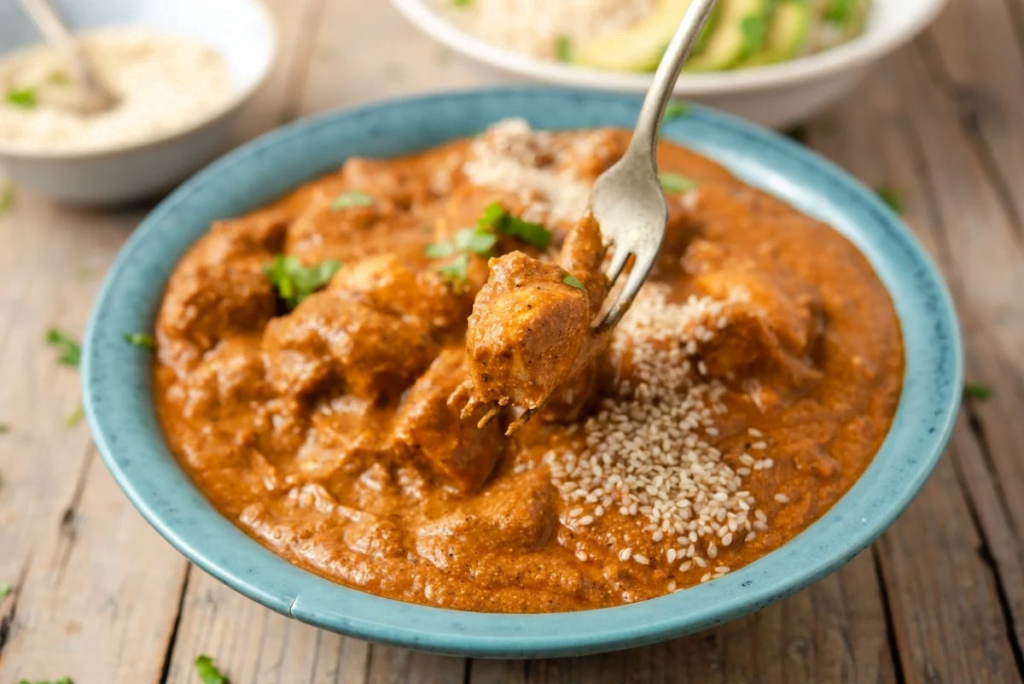
Another favorite Guatemala cuisine dish is the pepián. This flavorful stew is made with chicken or beef, pumpkin seeds, sesame seeds, and spices that include cinnamon, cumin, and coriander. The pepián is traditionally served with rice and tortillas, which are perfect for soaking up the delicious sauce.
Here’s a detailed recipe for Pepián de Pollo, a traditional Guatemalan dish:
Pepián de Pollo – Guatemala cuisine Spiced Chicken Stew
Guatemalan Cuisine – Pepián Ingredients:
- Chicken, cut into serving pieces, with skin and fat removed
- Water
- Fresh Roma tomatoes
- Chile pasa (ancho or pasilla), dried with seeds and stem removed
- Chile guaque (guajillo), dried with seeds and stem removed
- White onion
- Sesame seeds (ajonjoli)
- Shelled pumpkin seeds (pepita)
- Cinnamon stick
- Dried achiote
- Cilantro
- Corn tortillas or French bread
- Salt to taste
- Pre-cooked fresh vegetables such as green beans (stems removed), huisquil (peeled and chopped into large pieces) or potato (peeled and chopped)
Guatemala cuisine – Spiced Chicken Stew Instructions:
- Begin by cutting the chicken into serving-sized pieces and simmering it in 5 cups of water with salt for 30 minutes. Skim off and discard any grey scum that may form while cooking. Drain and reserve the broth for the sauce.
- Dry roast (toast) the cinnamon stick, pumpkin seeds, and sesame seeds separately in a dry skillet (with no oil) until browned but not burned. The pumpkin seeds will pop when they’re fully toasted.
- Dry roast (toast) two corn tortillas (or a piece of crusty French bread) in the same dry skillet. Remove from the pan, pour a small amount of water over it to moisten, and set aside.
- Char the Roma tomatoes, chiles (stems and seeds removed), and onion over a dry skillet in batches until very well browned.
- Process the toasted seeds and cinnamon stick in a spice grinder or food processor until they are a very fine powder.
- Add the charred tomatoes, chiles, and onion to the food processor. Don’t peel the tomatoes or onions as you want the charred skins included in the sauce.
- Add the achiote, cilantro, and a half teaspoon of salt to the mixture. Process for several minutes until very smooth.
- Add the toasted and soaked corn tortillas (or French bread) and four cups of reserved chicken broth to the tomato and seed mixture and process until very smooth.
- Pour the sauce into the pot, bring to a low boil. Add the chicken. Simmer over low heat for 15 minutes or longer until the sauce is very thick and a deep red color. Add more water or broth if you prefer a thinner consistency.
- Add the chopped and pre-cooked vegetables (if using) at the very end.
Guatemala cuisine – Spiced Chicken Stew Serving
Serve with a sprinkling of toasted sesame seeds or finely chopped cilantro, white rice, and wedges of fresh avocado on the side.
Finally
This dish is a velvety chicken stew and is often considered the national dish of Guatemala. It features tender chicken pieces in a lightly spiced tomato, toasted pumpkin seed, and chile sauce. Aromatic and packed with flavor, this Mayan-inspired stew is perfect for parties and is surprisingly easy to make.
Guatemalan Cuisine – Camarones al ajillo

For those who prefer seafood, Guatemala cuisine offers the camarones al ajillo – a must-try dish. This garlic and shrimp dish is usually served with white rice and avocado slices, creating a refreshingly light meal that packs a punch of flavor.
When it comes to Guatemalan food specialties, tamales are a staple. These delicious bundles of masa (corn dough) are filled with savory ingredients such as chicken, pork, or vegetables and then wrapped in banana leaves before being steamed. Tamales are often eaten for breakfast, accompanied by a cup of hot chocolate.
Here’s a detailed recipe for Camarones al Ajillo, a popular Guatemala cuisine dish in many Latin American countries, including Guatemala:
Guatemalan Cuisine – Camarones al Ajillo (Garlic Shrimp)
Ingredients:
- 1 lb. large shrimp, peeled and deveined.
- ½ cup extra virgin olive oil
- 10 garlic cloves, chopped
- 1 teaspoon red pepper flakes (adjust to your preference for heat)
- 1 teaspoon paprika
- 2 tablespoons dry sherry or dry white wine
- Juice of ½ lemon
- ½ cup chopped fresh parsley
- Kosher salt, to taste
- Crusty bread, for serving
Guatemala cuisine – Camarones al Ajillo Instructions
- Preparation: Pat the shrimp dry and season them with kosher salt. Set them aside.
- Cooking the Garlic: In a large skillet, heat the extra virgin olive oil over medium heat until it’s shimmering but not smoking. Add the chopped garlic and red pepper flakes. Cook them over medium heat for up to 60 seconds or until the garlic starts to color. Be careful not to burn the garlic.
- Cooking the Shrimp: Add the shrimp to the skillet and sprinkle them with paprika. Toss and cook briefly, ensuring that the shrimp turn opaque and have a pearly pink color. This should take about 3 minutes or so, but the exact time will depend on the size of the shrimp.
- Finishing the Dish: Remove the skillet from the heat and stir in the sherry, lemon juice, and fresh parsley.
- Serving: Transfer the shrimp and the sauce to a serving bowl. Serve them with crusty bread to soak up the delicious garlic-infused olive oil sauce.
Tips
- Use quality extra virgin olive oil, as its flavor is crucial to the sauce.
- Be cautious when cooking the garlic. If it burns, it can make the sauce bitter.
- The shrimp will cook quickly, especially if they are large. Watch for the flesh to turn opaque and pink. Even after you remove the skillet from the heat, the shrimp will continue to cook in the warm sauce.
This dish is perfect as an appetizer or even a main course when served with rice or pasta. The garlic-infused olive oil sauce is the highlight, and having some crusty bread to dip into it is a must!
Guatemalan Cuisine – Chancletas

Finally, no exploration of Guatemalan food specialties is complete without mentioning the sweet treats. The most famous of these is probably the chancletas, which are deep-fried doughnuts coated in sugar and cinnamon. Another sweet Guatemala cuisine delicacy is the camote en dulce, a type of sweet potato dish cooked in sugar syrup with cinnamon and cloves.
These are just some of the many Guatemalan food specialties that showcase the diverse flavors of this amazing cuisine. From fiery spices to sweet treats, the flavors of Guatemala are sure to leave you wanting more.
Here’s a detailed recipe for Guatemalan Chancletas, a unique and delightful dessert made with chayote squash:
Guatemala cuisine – Chancletas (Stuffed Chayote Dessert)
Ingredients for Cooking the Chayotes:
- 2 large chayotes
- 5 cups of water
- ½ cup sugar
- 1 cinnamon stick
- 2 whole cloves
The Filling:
- 1 medium champurrada (Guatemalan cookies)
- 3 tablespoons of chopped almonds
- 3 tablespoons of raisins
- 1 teaspoon of ground cinnamon
- 1 pinch of salt
- 3 egg yolks
- 3 tablespoons of light brown sugar
- ½ teaspoon of vanilla extract
Ingredients for the Topping:
- Sliced almonds
- Raisins
Guatemala cuisine – Chancletas Instructions:
- Preparing the Chayotes: Start by cutting the chayotes in half lengthwise. In a large pot, combine water, cinnamon stick, whole cloves, and sugar. Bring the mixture to a boil and add the chayotes. Let them cook for approximately 20 minutes until they become tender.
- Preparing the Filling: Once the chayotes have softened, carefully remove the flesh from the skin, ensuring not to damage the skin, and mash the flesh. Place the mashed chayote in a colander to drain off any excess water. Add all the filling ingredients to the mashed chayote and mix thoroughly.
- Stuffing and Baking: Stuff the chayote skins with the filling mixture. Top with raisins and almonds. Preheat the oven to 350°F (180°C), then bake the chayotes for 30 minutes until they are cooked through.
Variations
- Some versions of the chancletas recipe include sweet red wine or sherry. If you’d like to try this, simply add two teaspoons of sherry or sweet red wine to the filling mixture.
- Another version adds a crumble topping made by mixing champurrada crumbs and melted butter. You can add this to the chancletas before baking and then top with the almonds and raisins on top of the champurrada crumble.
- If you don’t have champurradas, any bread crumbs will do. You can also add some shredded coconut to the chancletas for a tropical flavor.
This traditional Guatemalan dessert transforms the chayote squash into a sweet treat, showcasing the versatility of this vegetable. The combination of flavors and textures makes it a delightful dish to enjoy.
Guatemalan Cuisine – Chiles Rellenos
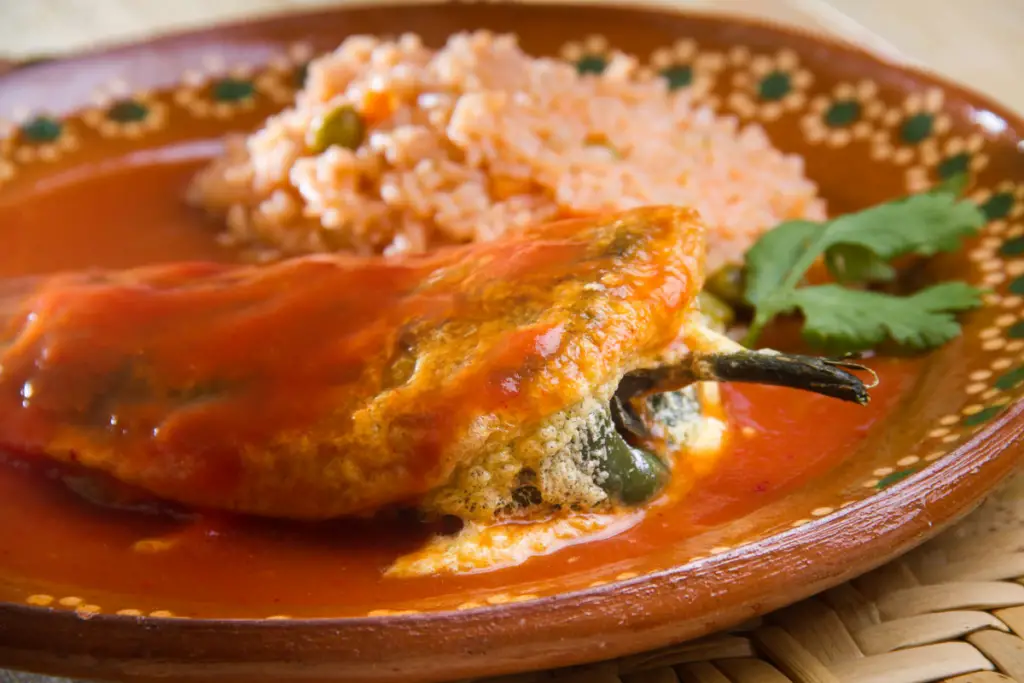
One of the most popular dishes in Guatemala cuisine, chiles rellenos are a flavorful combination of spicy chiles, meat, vegetables, and cheese, all wrapped up in a crispy egg batter. Here’s how to make them at home:
| Guatemala cuisine Ingredients: | – 6 large poblano peppers – 1 lb ground beef – 1/2 cup chopped onions – 1/2 cup chopped tomatoes – 1/2 cup chopped potatoes – 1/2 cup chopped carrots – 1 cup shredded cheese – 4 eggs – Salt and pepper to taste – Oil for frying |
|---|---|
| Instructions: | 1. Roast the peppers over an open flame or under a broiler until blackened. 2. Place peppers in a plastic bag and let cool for 10 minutes. 3. Peel off blackened skin and make a small slit down the side of each pepper. 4. Remove seeds and membranes from the peppers. 5. In a skillet, brown the beef with onions, tomatoes, potatoes, and carrots. 6. Stuff each pepper with the beef mixture and shredded cheese. 7. Beat the eggs in a separate bowl and season with salt and pepper. 8. Dip each stuffed pepper in the egg mixture, making sure it is completely coated. 9. Heat oil in a skillet over medium-high heat. 10. Fry the peppers until golden brown on all sides. 11. Serve hot and enjoy! |
Guatemalan Cuisine – Tamales
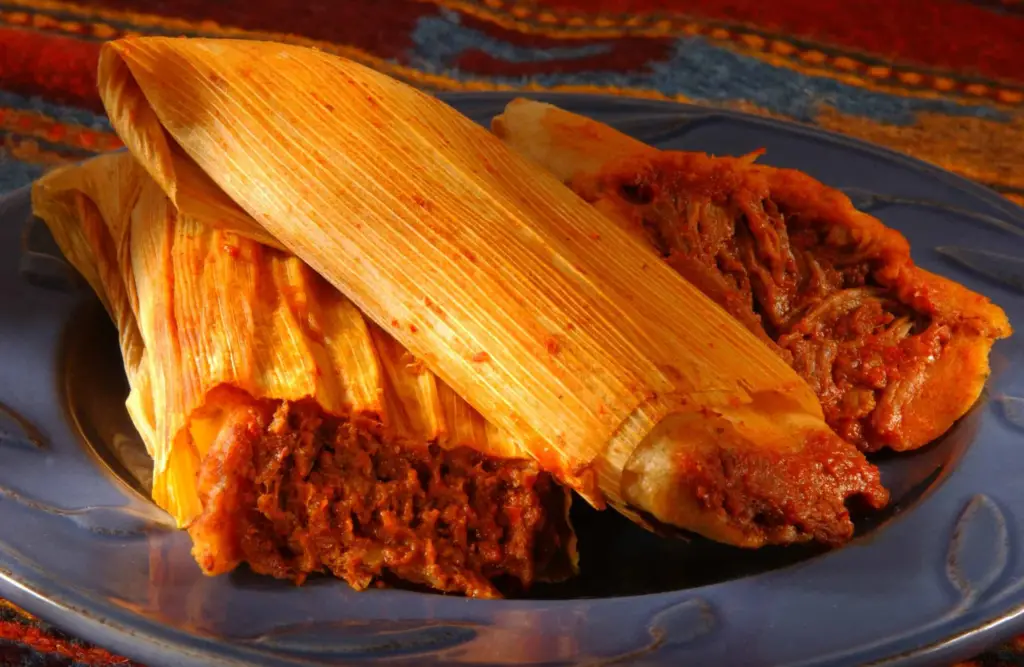
Tamales are another staple in Guatemalan cuisine, made with a corn-based dough called masa that’s filled with savory meats or vegetables and wrapped in banana leaves. Here’s how to make them:
| Guatemala cuisine Ingredients: | – 2 cups masa harina – 2 cups chicken broth – 1/2 cup lard or shortening – 1 tsp baking powder – Salt and pepper to taste – 2 cups cooked and shredded chicken – 1 cup tomato sauce – 1/2 cup sliced olives – 1/2 cup chopped cilantro – Banana leaves for wrapping |
|---|---|
| Guatemala cuisine Instructions: | 1. In a large bowl, mix together masa harina, chicken broth, lard or shortening, baking powder, salt, and pepper to form a smooth dough. 2. In a separate bowl, mix together shredded chicken, tomato sauce, olives, and cilantro. 3. Cut banana leaves into rectangles and soften them by placing them in hot water for a few minutes. 4. Spread a layer of masa dough over each banana leaf rectangle, leaving room at the edges. 5. Spoon the chicken mixture onto the center of the dough. 6. Fold the edges of the banana leaf over the filling to encase it in the dough. 7. Place the tamales in a steamer basket, making sure they’re standing upright. 8. Steam for about 1 hour, until the masa is cooked through and the tamales are firm. 9. Serve hot and enjoy! |
Guatemalan Cuisine – Fiambre: A Traditional Guatemalan Recipe

Fiambre is a Guatemalan dish prepared once a year on November 1st for the Day of the Dead or Día de Los Muertos. It’s a cold salad made from a variety of vegetables, cold cuts, cheeses, and a delicious caldillo. Due to its complexity, it may include more than 50 ingredients, and it’s recommended to start prepping at least one day in advance.
Guatemalan Cuisine – Fiambre Ingredients:
Vegetables:
- ½ lb. asparagus
- 6 beets, sliced or julienned
- 6 carrots, sliced or julienned
- 4 cups green beans
- 1 cauliflower, cut in sections
- 1 cabbage, cut in fine long pieces
- 1 lb. Brussels sprout
- 2 cups corn (shelled)
- 25 pacayas (found fresh in Latino markets, or use canned)
- 1 jar heart of palm
- 1 jar of pickled baby corn
- 1 jar of pickled baby onions
- ½ lb. red beans (canned)
- ½ lb. white beans (canned)
- 1 can chickpeas
- 4 cups green peas
- 1 lb. fava beans (fresh)
- ¼ lb. capers
- ¼ lb. green olives
- ¼ lb. black olives
- 1 can of pimentos
- 1-2 heads of lettuce
- Radish roses for garnish
Meats:
- ½ lb. butifarra (sausage made with anis and other spices)
- ½ lb. cecina (dried smoked and salted beef)
- 1 lb. chicken (cooked, removed from the bone, cut in long strips)
- 1 lb. chorizo Colorado (red chorizo sausage, sliced)
- 1 lb. black chorizo sausage, sliced
- 1 lb. yellow chorizo sausage, sliced
- ½ lb. hot dog, cooked and sliced
- 1 lb. ham, cut in long strips
- ½ lb. longaniza (sausage with mint and chile, can use Italian sausage)
- 1 lb. mortadella, cut in large cubes
- 1 lb. salami, cut into large cubes
- 1 lb. hot dog, cut lengthwise
- ½ lb. salted cow tongue
Eggs and Dairy:
- 2 eggs (hard-boiled)
- ½ lb. yellow or American cheese (cut into strips)
- 2 hard-boiled eggs
- Queso fresco (1 small)
- ½ lb. Zacapa cheese (can use good parmesan)
Dressing or caldillo:
- 1 bunch of parsley
- 4 bay leaves
- 2 sprigs of thyme
- 1 sprig of oregano
- 1 quart of vinegar
- 1 pint of olive oil
- 6 tablespoons mustard (preferably dark, grainy mustard)
- 1 teaspoon of pepper
- Salt to taste
- 5 tablespoons Worcestershire sauce
- 1 tablespoon nutmeg
Guatemala cuisine – Fiambre Preparation
- Two Days Before Serving: Boil each group of vegetables separately. Boil the beets until just cooked but still firm. Boil carrots and green beans together until just done. Next, boil cauliflower and cabbage. Finally, boil peas, fava beans, and corn. Boil the chicken with parsley, adding salt and pepper to taste. Shred the cooked chicken and store it. Blend the broth with vinegar, olive oil, mustard, salt, pepper, Worcestershire, bay leaves, thyme, oregano, and nutmeg. Simmer for ten minutes, then chill overnight.
- The Day Before: Boil the chorizos with butifarras. Chop all meats so they’re ready for assembly. Combine all veggies and pour the chicken broth mixture over it. Let it sit overnight in the refrigerator.
- Early in the Day: Place a lettuce leaf on a plate, arrange a layer of the veggie mixture, then add a layer of the meats and cheeses. Repeat at least once and decorate with pimientos, sliced cheese, asparagus, baby corn, radishes, olives, and boiled eggs. Serve chilled.
Safety Notes: Ensure proper handling and storage of all ingredients. It’s easier to cut everything up and store it separately in Ziplock bags. Refrigerate washed and cut-up vegetables together, but keep meats and cheeses separate.
Enjoy your Fiambre with a refreshing glass of rosa de Jamaica or agua de tamarindo. On colder days, warm up with some chocolate caliente with chiquiadores or a delicious atol de elote.
Buen Provecho! (Source – Link)
Get creative and experiment with different ingredients to put your own unique twist on these traditional dishes!
Guatemalan Food – Chuchito

History and Background
Embarking on a culinary exploration in Guatemala brings us to the heart of its rich traditions, and one dish that stands out is the Chuchito. Originating from the Mayan influences that permeate Guatemalan cuisine, Chuchito is a beloved dish enjoyed during festivals and gatherings.
These savory delights, wrapped in corn husks and steamed to perfection, showcase the diverse flavors of Guatemala, where history and heritage meld seamlessly on the plate.
Guatemalan Food – Chuchito Ingredients
Prepare to savor the authentic taste of Guatemalan Chuchito with these traditional ingredients:
- 2 cups masa harina (corn flour)
- 1 cup chicken broth
- 1/2 cup tomato sauce
- 1/4 cup vegetable oil
- 1 teaspoon baking powder
- 1/2 teaspoon salt
- 1/2 teaspoon achiote powder (optional, for color)
- 1 cup cooked and shredded chicken
- 1/2 cup chopped bell peppers (mixed colors)
- 1/4 cup chopped green onions
- 1/4 cup chopped fresh cilantro
- Corn husks for wrapping
Guatemalan Food – Chuchito Recipe
1. Prepare the Masa Dough
- In a large mixing bowl, combine masa harina, chicken broth, tomato sauce, vegetable oil, baking powder, salt, and achiote powder if using. Mix until a soft, pliable dough forms.
2. Mix in the Filling
- In a separate bowl, combine shredded chicken, chopped bell peppers, green onions, and fresh cilantro. This will be your flavorful filling.
3. Assemble the Chuchitos
- Take a corn husk and spread a small amount of masa dough on it, forming a square or rectangle.
- Spoon a portion of the filling onto the center of the masa dough.
4. Fold and Tie
- Fold the sides of the corn husk over the filling and then fold the top and bottom, creating a small rectangular package.
- Tie the Chuchito with a thin strip of corn husk to secure.
5. Steam to Perfection
- Arrange the Chuchitos in a steamer basket and steam for approximately 45-60 minutes or until the masa is cooked through.
6. Serve and Enjoy
- Unwrap the Chuchitos, revealing the delicious steamed masa and savory chicken filling. Serve warm and enjoy the authentic flavors of Guatemala.
Serving and Nutritional Information
This Chuchito recipe yields approximately 12 Chuchitos and takes around 1 hour to prepare. Each Chuchito is estimated to be around 150 calories, offering a delightful mix of carbohydrates and protein.
Delight in the flavors of Guatemala with these steamed delights, perfect for sharing with friends and family. So, unwrap the taste of tradition, share the joy, and savor the essence of Guatemalan Chuchitos!
Guatemalan Cuisine – Caldo de cabeza
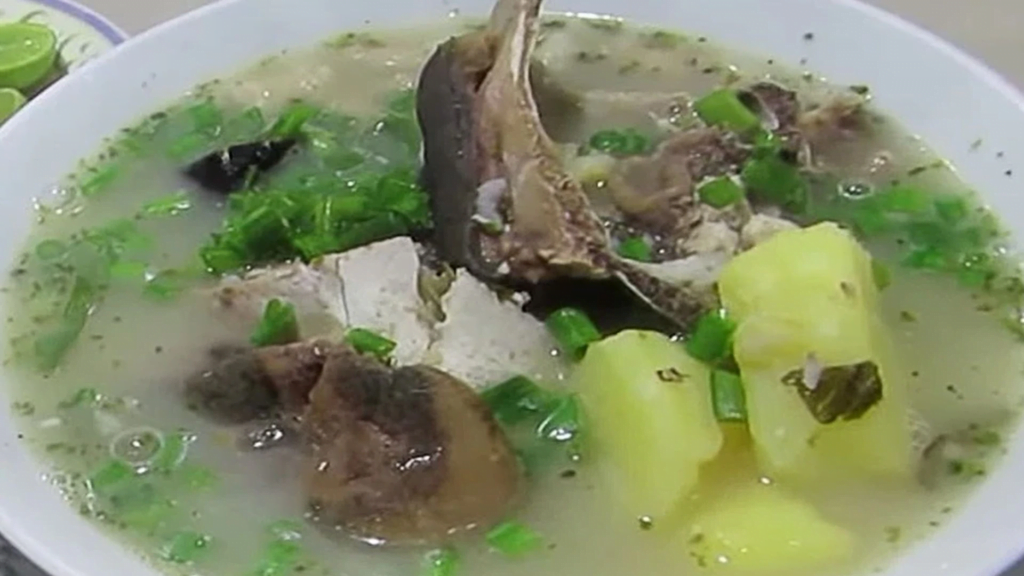
Here’s a detailed recipe for Caldo de Cabeza, a traditional Peruvian dish:
Caldo de Cabeza (Beef Head Soup)
Making the soup involves cutting a Cow’s head in half and letting it, along with everything inside, cook in a broth with turnip and parsley. Chefs traditional serve it until 11:00 am and is consumed by locals for breakfast. The soup can include parts like the brain and even eyeballs.
Guatemalan Cuisine – Caldo de cabeza Ingredients:
- 1 whole beef head
- 1 onion, chopped
- 8 garlic cloves, minced.
- 1 tbsp cumin
- 1 tbsp dried oregano
- 2 bay leaves
- 6 cups of water
- Salt to taste
- 6 potatoes, peeled and quartered.
- 3 ears of corn, husked and cut into thirds.
- 1 lb. of yucca, peeled and cut into 2-inch pieces.
- 2 carrots, peeled and sliced.
- 1 red bell pepper, seeded and chopped
- 2 limes, juiced.
- Cilantro, chopped for garnish.
Guatemalan Cuisine – Caldo de cabeza Instructions:
- Rinse the beef head under cold running water and place it in a large pot.
- Add the chopped onion, minced garlic, cumin, dried oregano, bay leaves, and water to the pot. Season with salt to taste.
- Bring the pot to a boil, then reduce heat to a simmer and let cook for 2 hours or until the meat is tender.
- Remove the meat from the pot and set aside to cool.
- Remove any bones or cartilage from the meat and discard. Cut the meat into small pieces and return it to the pot.
- Add the potatoes, corn, yucca, carrots, and red bell pepper to the pot.
- Cover the pot and cook on low heat for another 30-40 minutes or until the vegetables are tender.
- Remove the bay leaves from the pot and stir in the lime juice.
- Ladle the caldo de cabeza into bowls and garnish with chopped cilantro.
- Serve hot and enjoy!
Conclusion
We hope this culinary journey through Guatemalan cuisine has left you feeling inspired and hungry for more. From the rich cultural history and traditions to the diverse range of ingredients and flavors, Guatemalan cuisine is a true gem of Central America.
As we celebrate the richness of Guatemalan cuisine, let us not forget the hardworking farmers, producers, and chefs who keep these traditions alive. Their dedication and passion for preserving the flavors and techniques of generations past is what makes Guatemalan cuisine so special.
At its essence, Guatemalan cuisine is a celebration of family, community, and the connection between the people and the land. Whether you’re enjoying a traditional meal with loved ones or savoring the flavors of Guatemalan street food, every bite is a testament to the rich cultural heritage of this beautiful country.
So, let’s raise a glass (or a spoon) to the deliciousness of Guatemalan cuisine. Here’s to the combination of flavors that make it so unique, the passion of those who create it, and the joy that it brings to our taste buds and our hearts.
FAQ’s
What is Guatemala cuisine?
Guatemalan cuisine refers to the traditional food and dishes of Guatemala, a Central American country. It has diverse flavors, blending indigenous Mayan ingredients with Spanish and African influences.
What is some Traditional Guatemalan Food?
Some popular traditional Guatemalan dishes include tamales, chiles rellenos, pepián (a spicy meat stew), and plátanos en mole (plantains in mole sauce).
What is Authentic Guatemalan Food?
Authentic Guatemalan food is known for its rich flavors and unique blend of Mayan and Spanish influences.
Popular dishes include pepian, a hearty meat stew, and tamales wrapped in banana leaves. Traditional ingredients like corn, black beans, and chilies are also commonly used. Sampling authentic Guatemalan food is a must for food enthusiasts looking to explore the country’s vibrant culinary culture.
What is the Guatemala National Dish?
Pepian, a traditional Mayan stew, is considered the national dish of Guatemala. It is made with chicken or beef, vegetables, and a rich sauce made from roasted sesame seeds, tomatoes, tomatillos, chili peppers, and other spices.
Pepian is often served with rice or tortillas.
How does Guatemalan food reflect the country’s culture?
Guatemalan food reflects the country’s cultural heritage through its use of indigenous ingredients, traditional cooking methods, and the importance of food in social gatherings and celebrations.
What are some Guatemalan food specialties?
Guatemalan food specialties include chuchitos (stuffed corn tortillas), tostadas (fried tortillas topped with various ingredients), and kak’ik (a ceremonial turkey soup).
Are there Guatemalan recipes available to try at home?
Yes! We provide authentic Guatemalan recipes with step-by-step instructions to help you recreate the flavors of Guatemala in your own kitchen. Check out our recipe section for inspiration.
What can I expect from Guatemalan street food?
Guatemalan street food offers a culinary adventure with a variety of snacks and treats. Try delights like chuchitos, tostadas, and garnachas (fried tortillas topped with beans, meat, and salsa) from the street food stalls and vendors.
What is Chancletas Food?
Chancletas food is a term used in some Caribbean countries to refer to cheap, street-style food. It is often sold at small roadside stalls or food trucks and includes a variety of dishes like empanadas, fried plantains, and grilled meats. Chancletas food is popular for its affordability and delicious flavors.
How has Guatemala cuisine evolved over time?
Guatemalan cuisine has embraced modern twists while still honoring its traditional roots. Innovative chefs and restaurants are reimagining classic dishes with new flavor combinations and presentation styles.
What is the significance of Guatemala cuisine?
Guatemalan cuisine celebrates the richness and diversity of the country’s gastronomic heritage. It allows people to explore the flavors, history, and cultural customs that have shaped Guatemalan food throughout the years.
